by Nishta Kumar
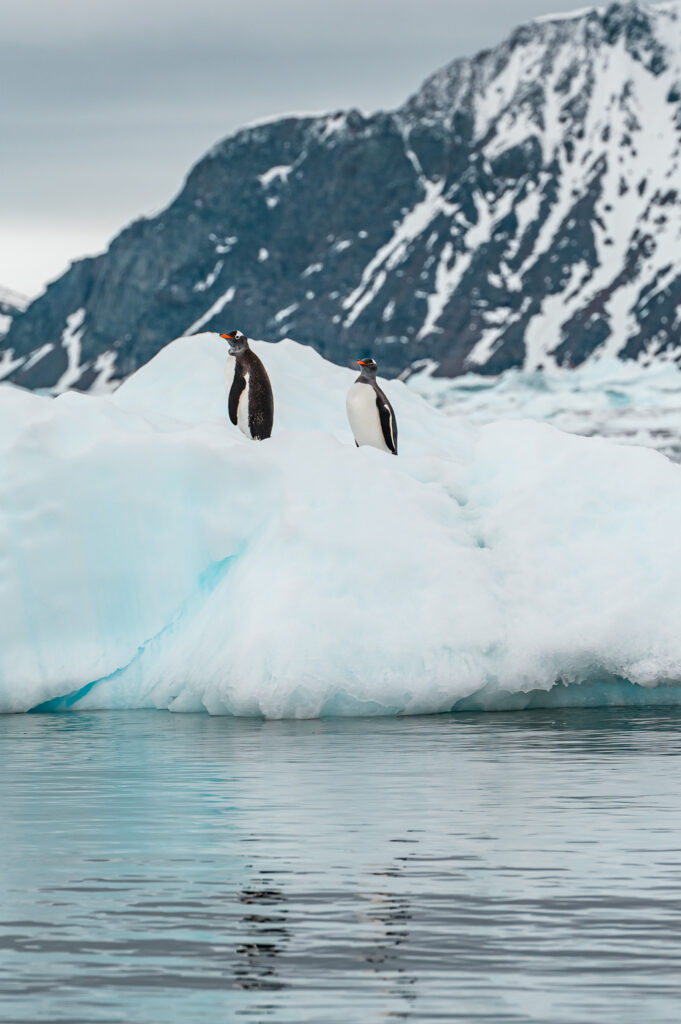
Traveling and seeing the world has been a paramount part of my life since I was 9 years old, and up until this trip I had been to 69 countries. So naturally, when I was first dating my husband Pranav, one of the questions I asked him was his list of places he wanted to travel. I was hoping it would be countries or cities that I hadn’t been to yet that we could explore together. Within seconds his response was “Antarctica!” I was completely thrown, it was definitely not a response I was expecting, but was thoroughly excited about. Once we planned our wedding, it was the very next big event we started saving and planning for and I am going to take you through the planning and packing, getting there, the expedition and thoughts post trip. If you want to skip ahead to the sections important to you or the penguin photos, please go ahead!
Disclaimer: This blog article is provided purely for information purposes and represents personal opinions only. It is not affiliated with, endorsed by or associated with any brand, company, or organisation.
Planning
From our initial research, we found out that the only way to get there was by cruise ship. As someone who worked on cruise ships for 3 years, I wasn’t keen on the idea. However, the ships that sail there and allow you to step on the continent itself are smaller expedition ships, which are very different to your regular holiday cruise ships. As per the IAATO regulations, only ships with less than 500 passengers (including crew) can do landings on the continent. These ships cater specifically to the expeditions, therefore, there aren’t any shows or entertainment, perhaps a few musicians and trivia games for sea days if anything.
One of the things most important to me in planning was our carbon footprint and not adding greatly to an increasing problem of global warming. However, the Antarctic Treaty and IAATO had already put in multiple rules to protect Antarctica that all expedition ships had to follow very strictly (which I will get to later).
In planning our trip we had to consider 3 things mainly:
- Budget
- Length of trip
- Time of year
In terms of budget, the minimum cost per person for a landing in Antarctica on the shortest of trips (7 days) was between $6-7k USD. This would only take you to one of the outer islands and back. There were many options of durations and cost from thereon:
- 10 days – $10k+ (Antarctic Peninsula and Shetland Islands)
- 15-19 days – $18k+ (Antarctica & Falklands)
- 22-25 Days – $26k+ (Antarctica, Falklands, and some other Southern Islands)
These were all trips leaving from South America, cruising out of the southern most ports of either Chile or Argentina. These are the best choices as they have the shortest distance to travel to the Antarctic Peninsula. We decided that a 10-day cruise fit our budget and length of trip the best. In terms of when, we didn’t have much of a choice, as the sailings only happen between October-March and with Australian leave periods, December was the best choice.
The next stage was choosing which Expedition company to go with, and here are some that we looked into:
- Nat Geo
- Seabourne
- Quark Expeditions
- Silversea Expeditions
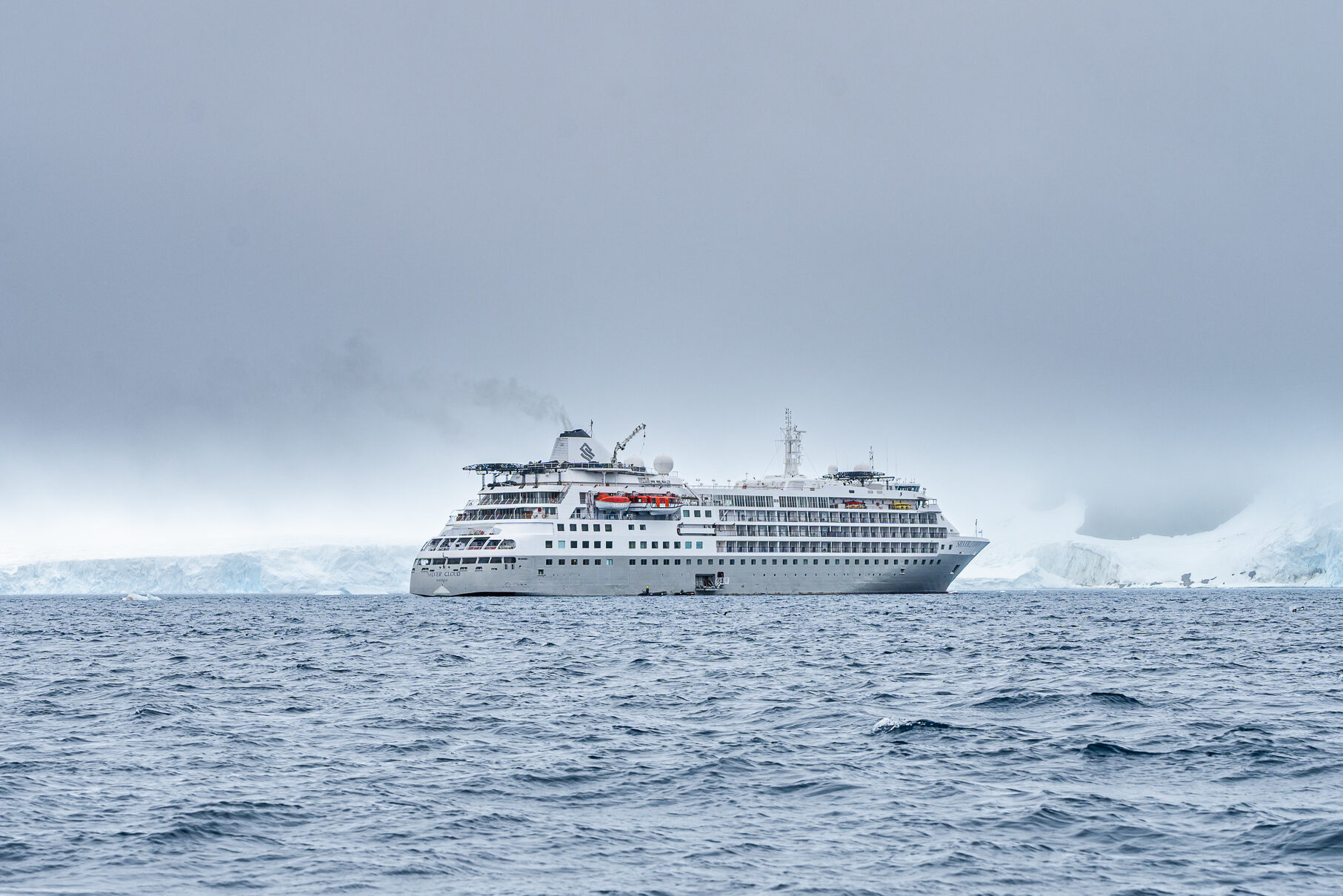
Each of the companies had a similar itinerary based on the trip length, and varied in price by about $2k. We chose to go with Silversea as they had the most competitive package and the itinerary started from Santiago, Chile which has direct flights from Melbourne (a massive advantage). You also can choose an itinerary that’s slightly cheaper where you have to get to the ports of Ushuaia, Argentina or Punta Arenas/Puerto Natales, Chile on your own, but given our limited knowledge of South America, we chose to use the straightforward option.
The other option is to do a Fly Cruise, this would mean that you fly from these ports on a small charter plane directly to King George Island, Antarctica and board your ship from there. Although this includes more flights and connections (and often more money) it avoids the infamously rocky seas of the Drake Passage.
Finally, once we decided the company and itinerary, it was time to choose from their different packages which are mostly based on the size of the cabin and benefits that it entails. Silversea had up to 8 classes of cabins ranging from the $10k/person Vista suite to the $35k/person Owner’s suite. The decision here is mainly if you want a balcony or you’re happy with just a window. Given that we had balconies surrounding the ship, we didn’t need the veranda or the large cabin, and chose the Vista suite. Also, if you are scared of getting seasick, best stick to a cabin in a lower deck and closer to the middle of the ship. After this, the cruise company will handle the rest and follow up with you if they require anything.
The final step to this, at least for us, was booking our tickets to/from Santiago, Chile and organising Visas. Yes Aussies! We need visas for Chile, but it’s a pretty simple process. Once you book your flight head to Info about Chilean Visas and it will give you the information to apply. The other great part is that there are direct flights from Sydney and Melbourne to Santiago, however they do not operate every day, so we chose to have 3 days before the cruise and 4 days after the cruise to work around our direct flights.
I think the most common question for an Antarctica cruise is, what do you need to pack? Here’s my list of what I believe are must haves (at least for the Silversea Expeditions):
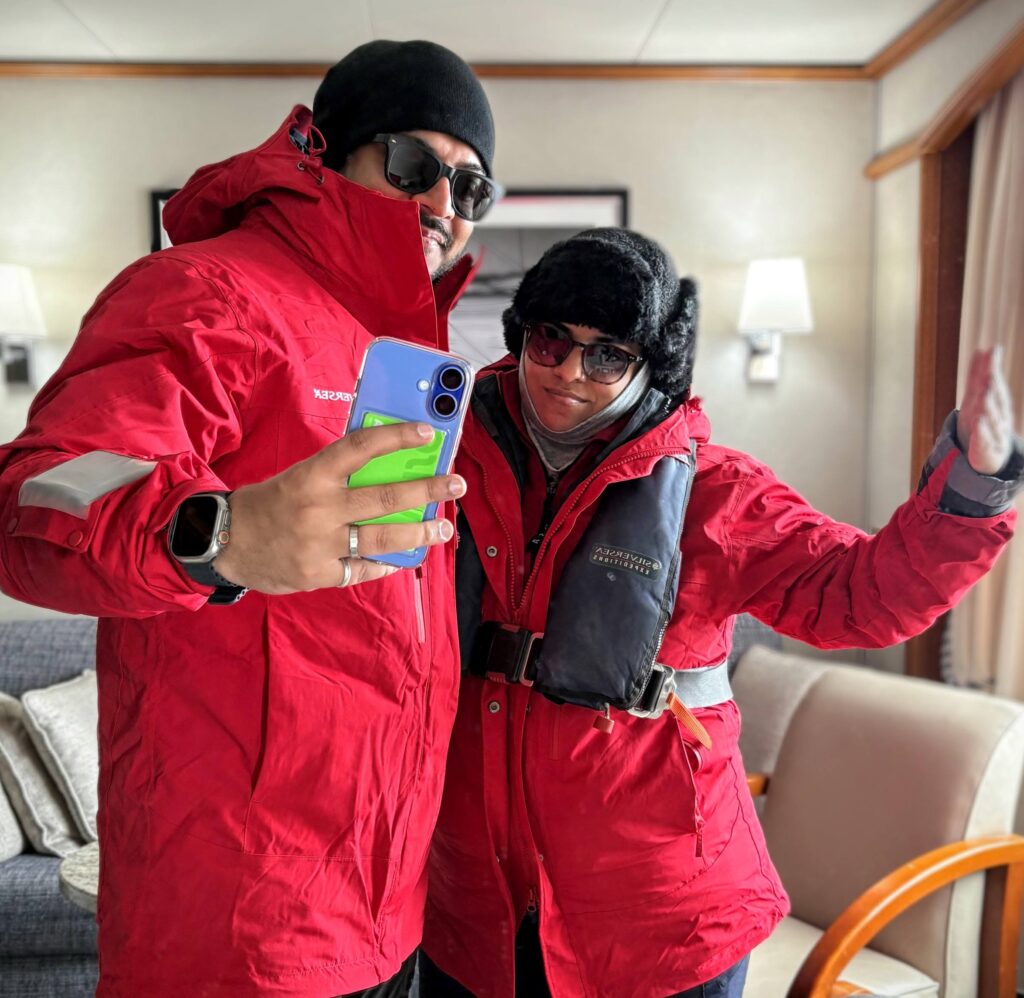
- 2 sets of thermals
- 2 pairs of waterproof pants
- 2 thin flannel sweaters/jackets
- 2 pairs of Thick woolen socks
- Gloves (preferably more waterproof with insulation)
- Beanie and Neck Gaiter
- Sunglasses & Sunscreen
- Waterproof insulated knee length boots (I recommend renting these from the ship instead of travelling with them since they are quite heavy and take up a lot of space)
- Regular clothes and necessities for around the ship and doing indoor activities (check your ships dress code)
- Optional: Swimmers/Bathers (if you want to use the ships pool or do the polar plunge)
- Optional: trekking poles, binoculars, Seasickness medication
They will provide a waterproof insulated Parka, a small backpack, and a water bottle.
And now, you’re ready for the greatest adventure of your life!
Getting There
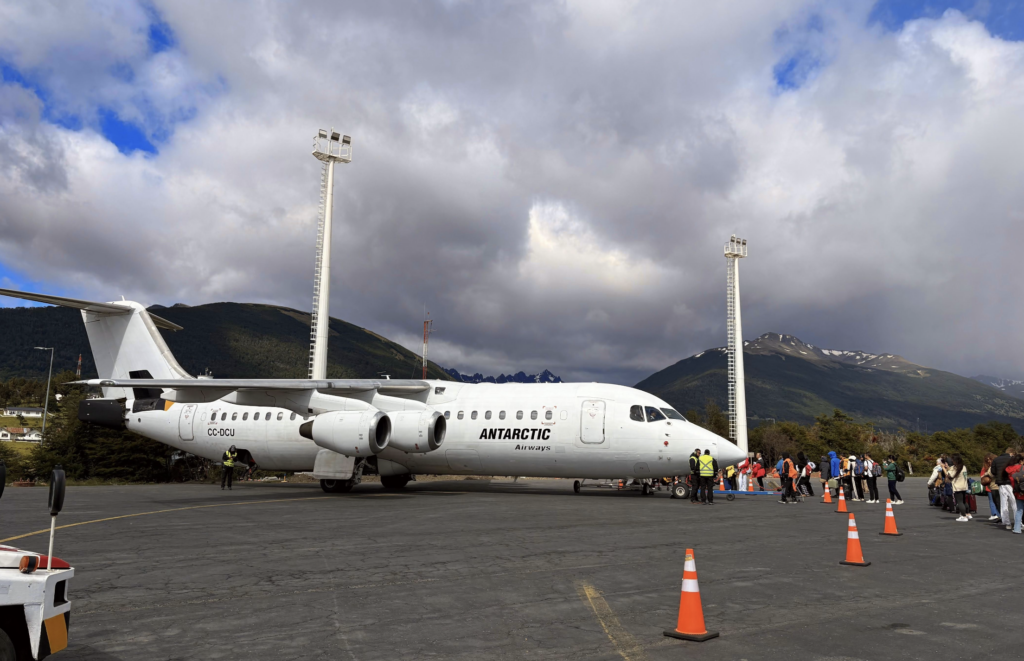
To get organised, Silversea had pre-booked a hotel in Santiago, Chile for the night before and after the cruise as the flights to the ship the next day were early in the morning. As we were already in Santiago a couple days before, we headed to the Ritz-Carlton (the hotel they booked) on the 8th of December around noon by Uber, and checked in with the Silversea staff there and hotel staff. All the information about your transfers, timings, and luggage will be provided to you there. Important reminder: you can only take 23 kg check-in luggage per person to the ship, as the flights are charter and very small so don’t take more than you need.
On the morning of the 9th we were taken by shuttle to the airport and boarded the first flight to Punta Arenas. From there we were split into 3 groups for the smaller charter plane to Puerto Williams and arrived at the ship around 4pm. Our check-in luggage, which we parted with at the hotel, was brought to our room by 6pm. After a lovely introduction to our cabin staff and safety briefing, it was time to start the Expedition Cruise!
The Expedition
Day 1 & 2
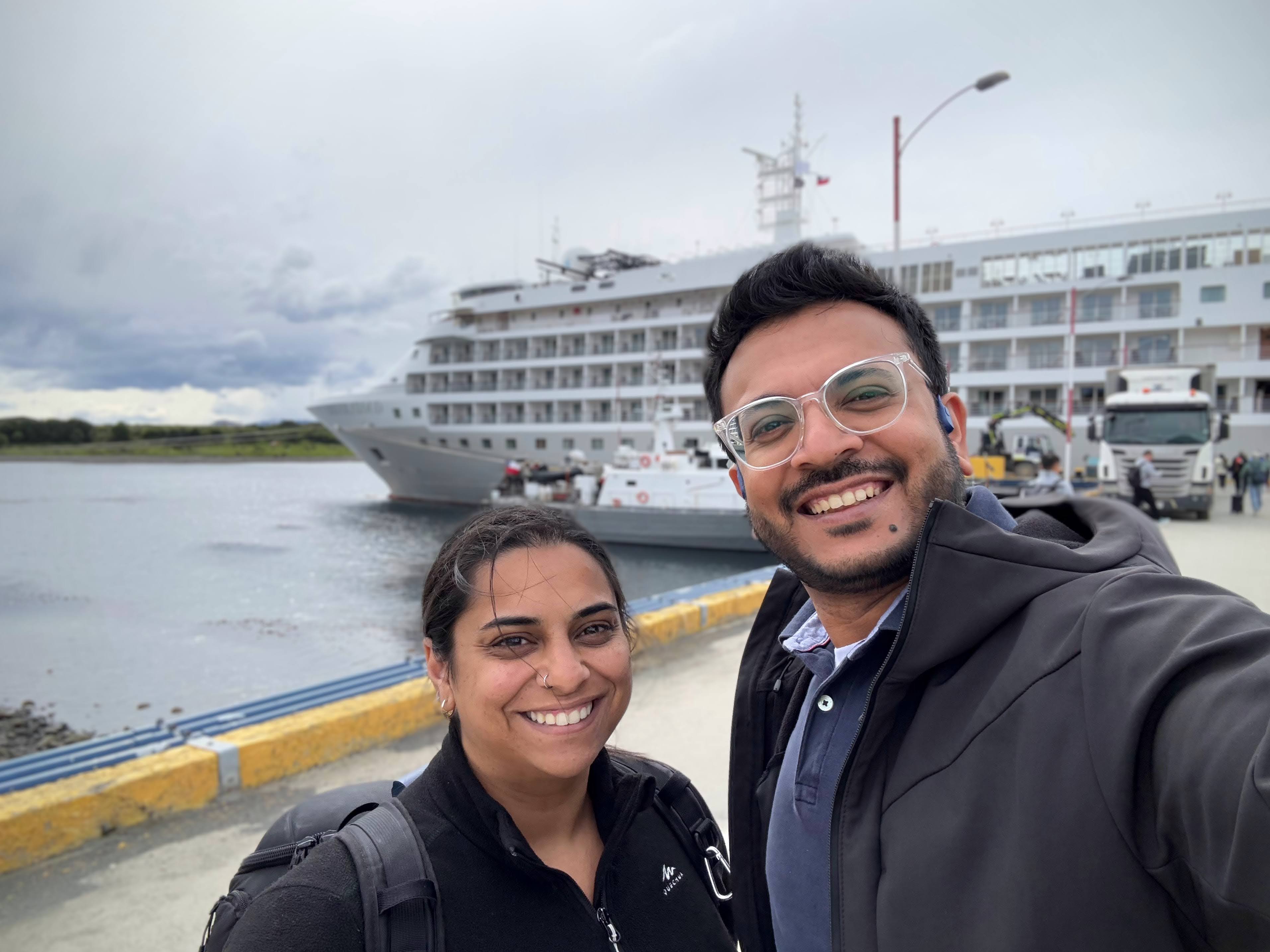
In our cabin there was a bottle of champagne to greet us, along with the introduction to our Personal Butler and Housekeeping Attendant. The cabin size was comfortable with a king size bed, a couch, a desk, 50-inch TV and a decent sized bathroom. Our chosen Parkas, bags, and bottles were already in the cabin along with the boots we had rented. A fun fact we found out was also that all the food and drink was included! This included even cocktails and barista coffee. We spent the first evening just exploring the ship and meeting other passengers and crew. There were 4 restaurants all serving different food, 2 indoor bars and 1 pool bar, a boutique, a 200-seater show lounge, and a photo studio with 20 computers for guests to use.
We had our first briefing with the expedition staff in the Show lounge, where they briefed us on proper Antarctica safety, etiquette, the wildlife, and what kind of landings we would have and how to prepare for them. They make sure all our outerwear is free of any remnants of other places such as dirt, seeds, or other artefacts. They also check our health to make sure we don’t introduce any illnesses to the continent or the wildlife. When we return to the ship they put our shoes/poles through a cleaning process to not allow any of Antarctica to be brought back.
The rest of the evening was just a peaceful sail out of Puerto Williams with a cocktail and great company.
Day 2 was a rough day at Sea going through the Drake Passage. The swells were up to 4m high so we passed the day with some Trivia games, a few more briefings from the expedition staff, casual chats with the bartenders, a sauna session, and promptly arriving for all our meals in the restaurants.
Day 3
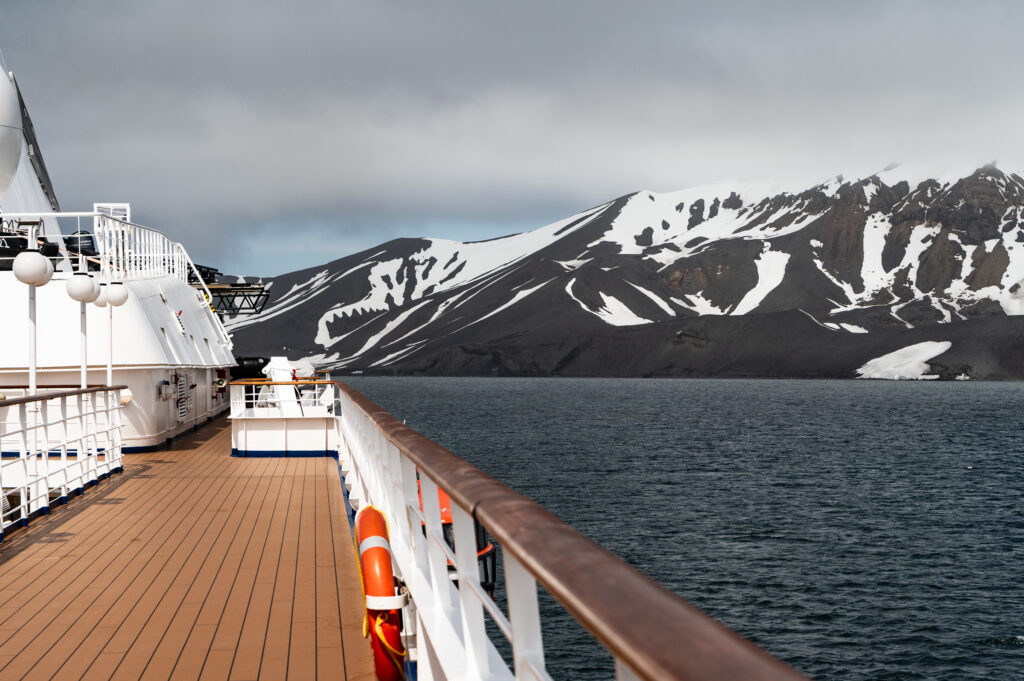
Today was supposed to be another day at Sea, but we were lucky with the weather and managed to score an extra port that wasn’t part of the itinerary. At around 1pm we sailed through Telefon Bay and docked near Deception Point. This was our first glimpse of the continent and it was gorgeous. There were mountains of black sand partially covered with snow, completely different to my expectations of just ice and snow.
The landing was a learning experience, as the weather was 0ºC with a rising wind chill we had to bundle up in some thermals, flannel, the parka, along with the waterproof pants above our leg thermals, thick woollen socks, a neck gaiter, a beanie, sunglasses, and gloves. There was a ‘mudroom’ on the 3rd deck where we stored our waterproof boots, so when our group was called we shuffled down in slippers with all our winter wear plus the life jackets they had provided, to go wear the boots in the mud room. Once we were ready we stepped in a cleaning solution (to make sure we didn’t carry any artefacts onto the land) and then all lined up to get into the Zodiac. The Zodiac is like a cross between a white water raft and a speedboat, specifically designed for these expeditions. From my knowledge, all the landing expeditions in Antarctica use Zodiacs. This was the main reason for bundling up, the wind when they zip us from the ship to land was freezing, and we were always at risk of getting splashed by the waves.
Once we arrived on Antarctica (the first time I couldn’t even believe it) we would be helped out one by one, sometimes having to step in the water as we walked on to the land. Then we removed the life jackets and put them in the specific bio-cleaned bins they had brought on to the land. The staff provided a briefing with a quick reminder of the rules, and offered us two options, either to explore on the flat land by the shore keeping close to the staff, or follow an expedition staff on a guided hike. We chose the hike and we decided that we would always choose that option after this first time.
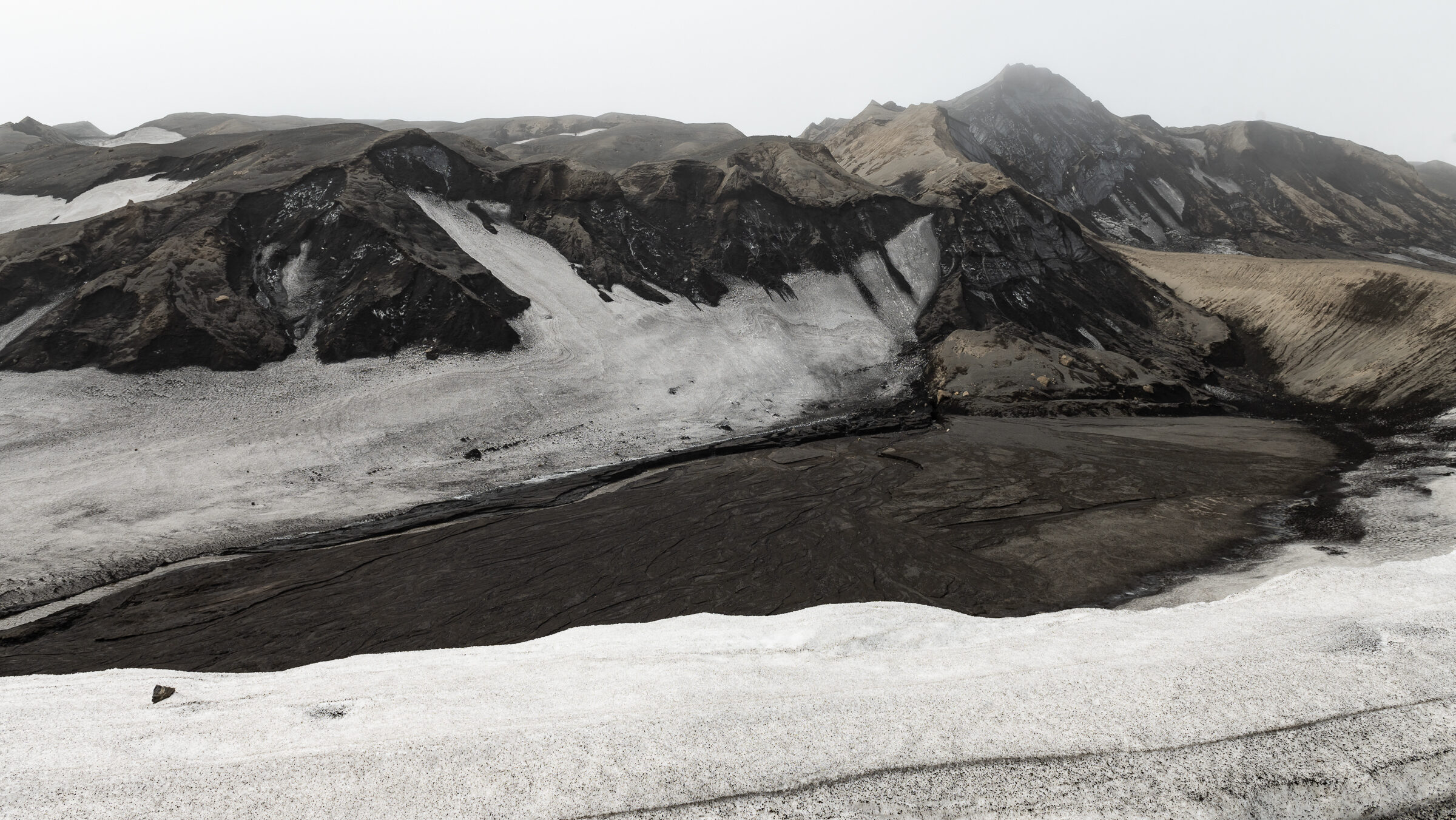
Our guide slowly navigated us up the hill to a freaking active volcano in Antarctica! It was spectacular as the land sprawled in front of us, with the fog rolling in, we could barely see the other guests below or the ship. We had to keep to the paths they had created for safety and environmental reasons, but they had created a route that allowed us to take breaks and work with each person’s physical abilities (with the option of always returning back). There were rock crevices, a fantastic volcano crater, and even little running streams. We even got our first glimpse of Gentoo penguins and a Fur seal. There were 2 penguins just chilling near the shore, and seeing them free in the wild for the first time was unreal. Little did we know that we would see thousands of penguins every day after this.
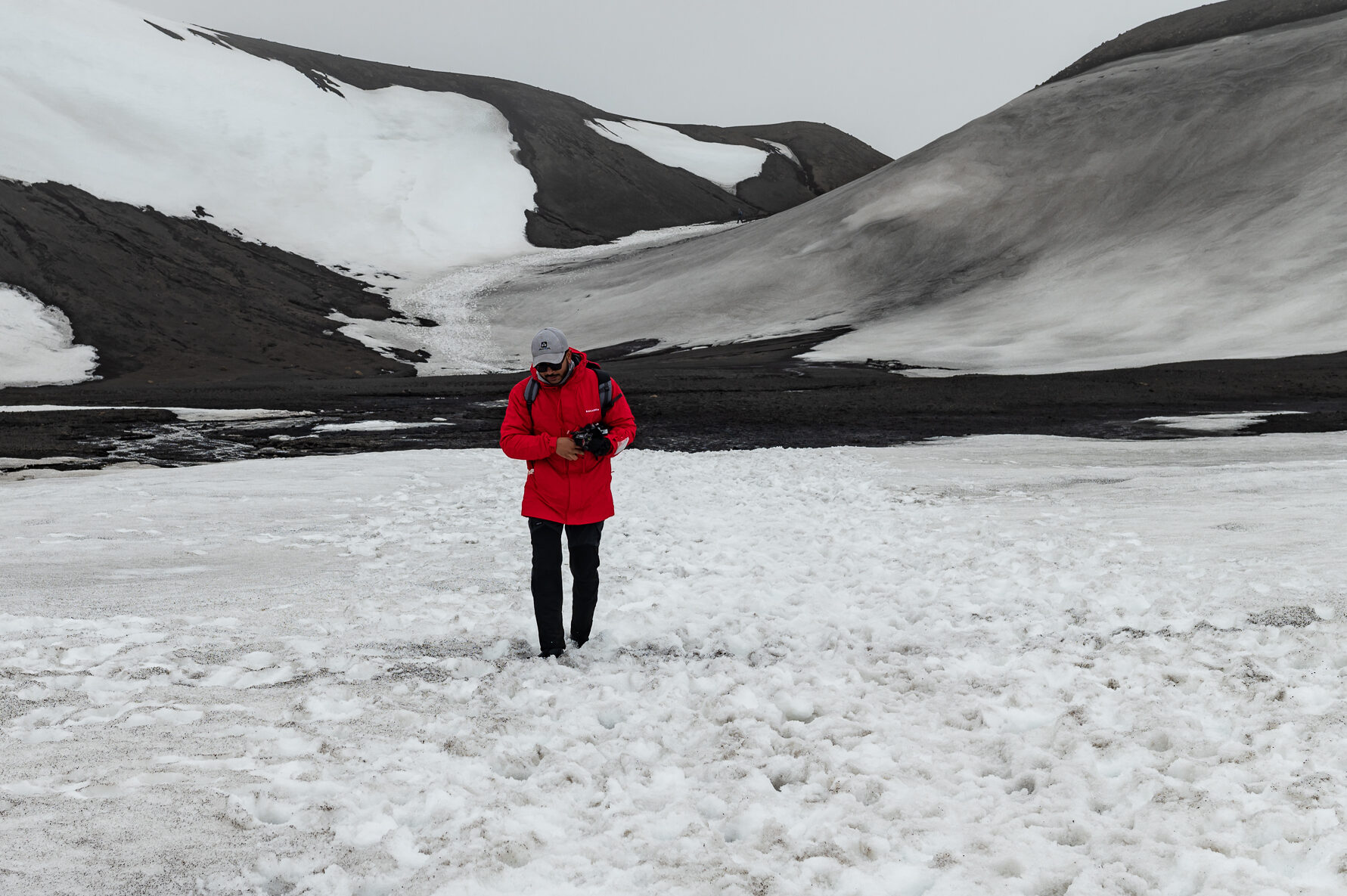
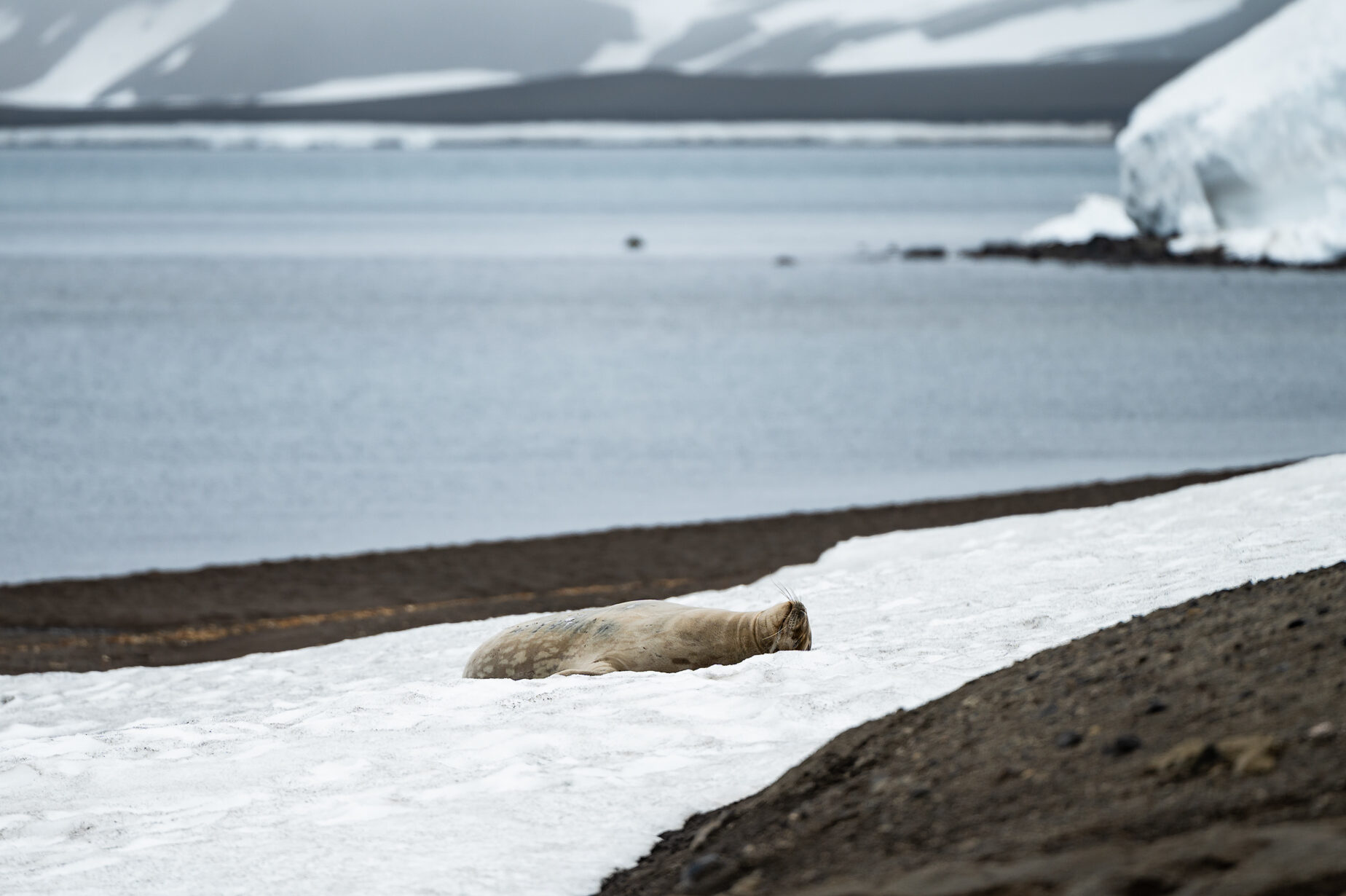
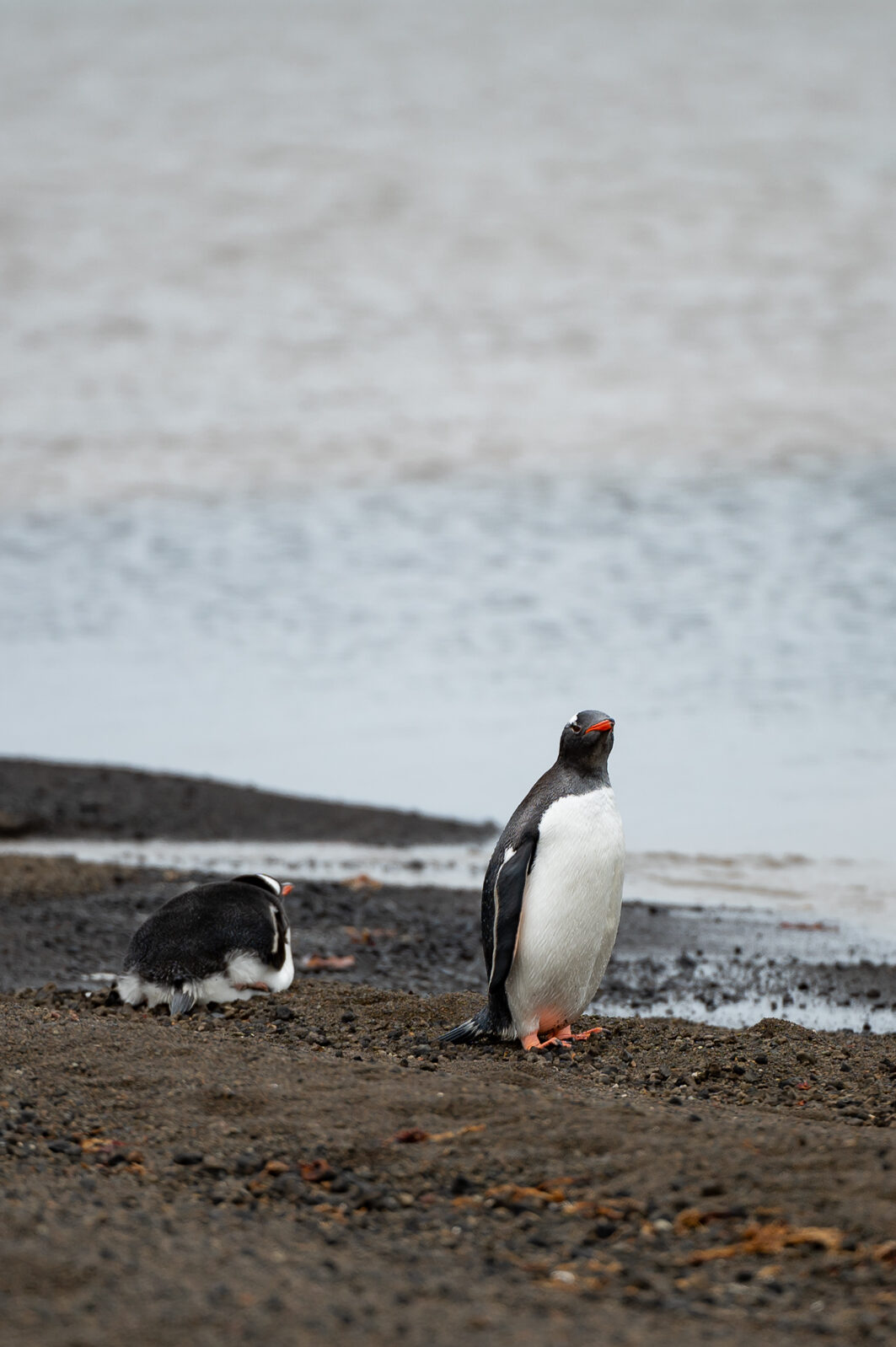
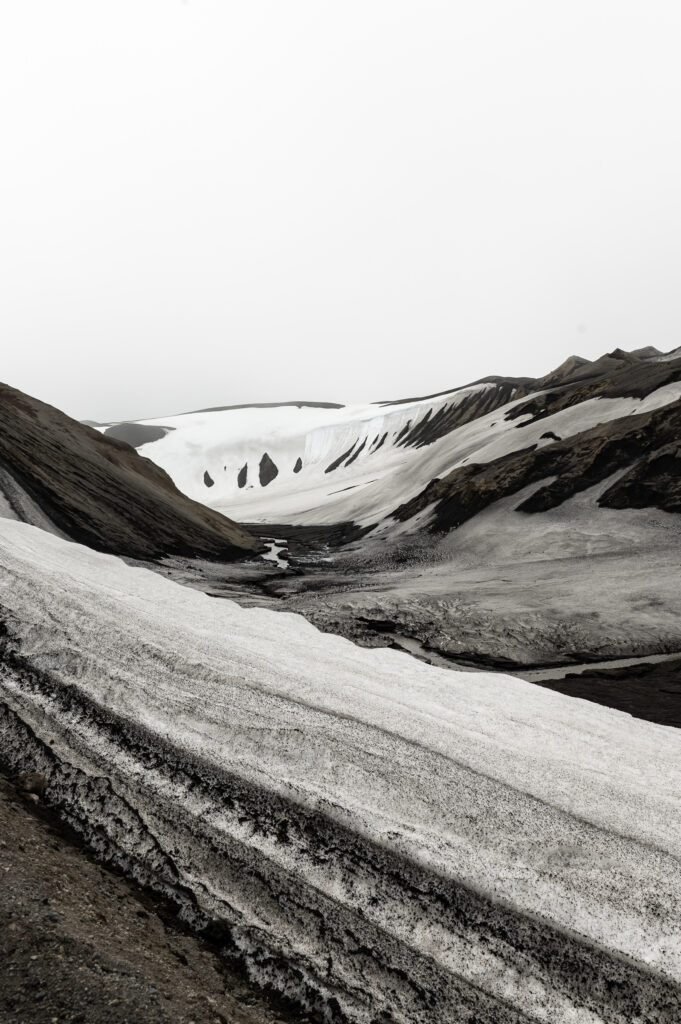
According to regulations, only 100 people at a time are allowed to make a landing, so we were only given about 1.5 hours before we had to return to the ship to make room for other guests to make a landing. Once we returned we had to walk through a boot cleaner machine, and then step in the cleaning solution again, before removing and storing our boots in the mud room. We were back in our cabins by 430pm, and had time to head up to the sauna to warm up again before freshening up for our evening briefing of the next day’s activities and heading to dinner; a routine we continued upon returning after each day’s expedition cruises or landings before we crashed by 10pm.
Day 4
So today I experienced first hand a polar summer, where the sun never sets or rises. I woke up at 2am, 4am, and 6am, thinking it was morning because it was constantly light outside even with the light-blocking curtains. Luckily, today our first landing was at 7am at Brown Bluff, so rising early was helpful. Unfortunately when the staff scouted the landing sight, they found traces of Bird flu amongst the wildlife, which automatically means that the landing is cancelled, but they found a way for us to still see the place up-close by taking us on a Zodiac cruise. For these excursions it was doubly important to dress warmly and waterproof since we were on the Zodiac for 1.5 hours.
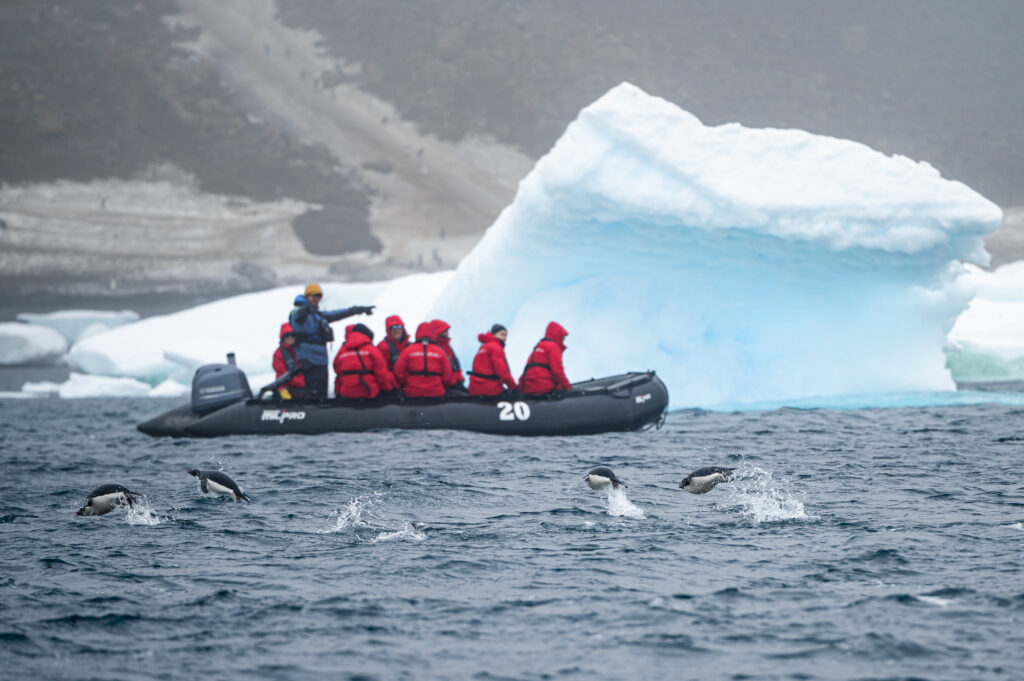
We were the first group out at 730am and it was even better than yesterday. The sheer colours of the icebergs we passed were different shades of white and bright blue with crazy shapes. The water was so clear that you could even see the shape of the iceberg under the water. What was even better was when we sailed around one of the icebergs we were met with a whole dozen of Adelie penguins hanging out huddled together on the ice. Almost every iceberg had a whole crew of penguins, nesting, flapping, flirting, or attempting to jump into the water. They were immensely cute, but also had a very distinct malodorous aroma. When we got closer to the mainland, we could see the whole population in the hundreds climbing up and down the hill.
We got back to the ship around 9am, but didn’t have to clean the boots since we never stepped out of the Zodiac. From then until 1:30pm we had free time so we changed into some regular clothes to hang out around the ship and get lunch. After the cold Zodiac, some guests chose to get in the Jacuzzi, which was always available.
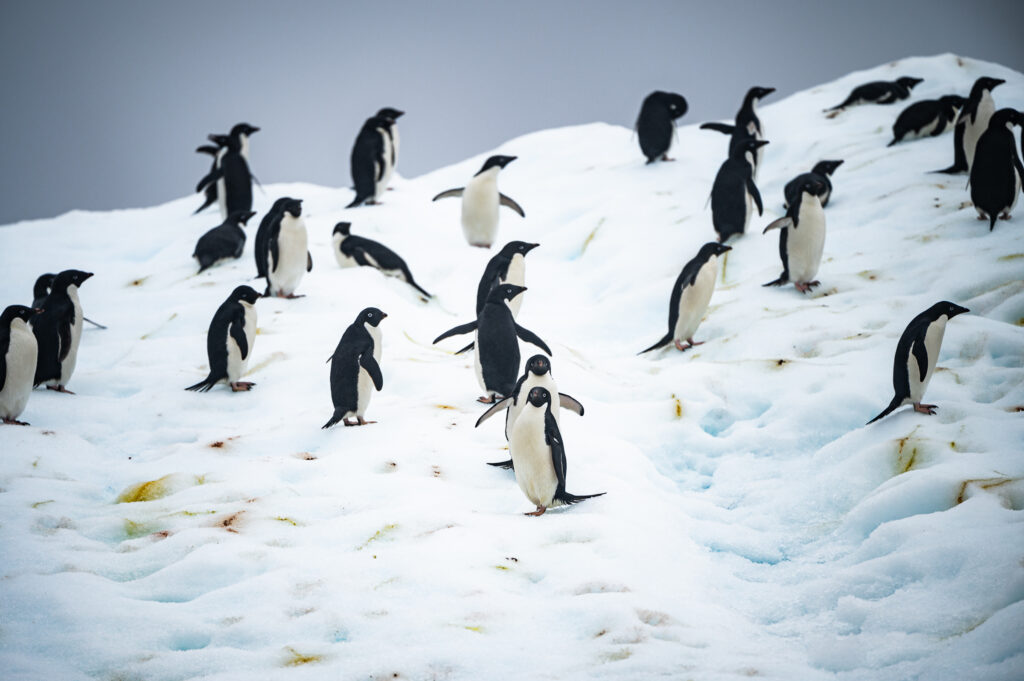
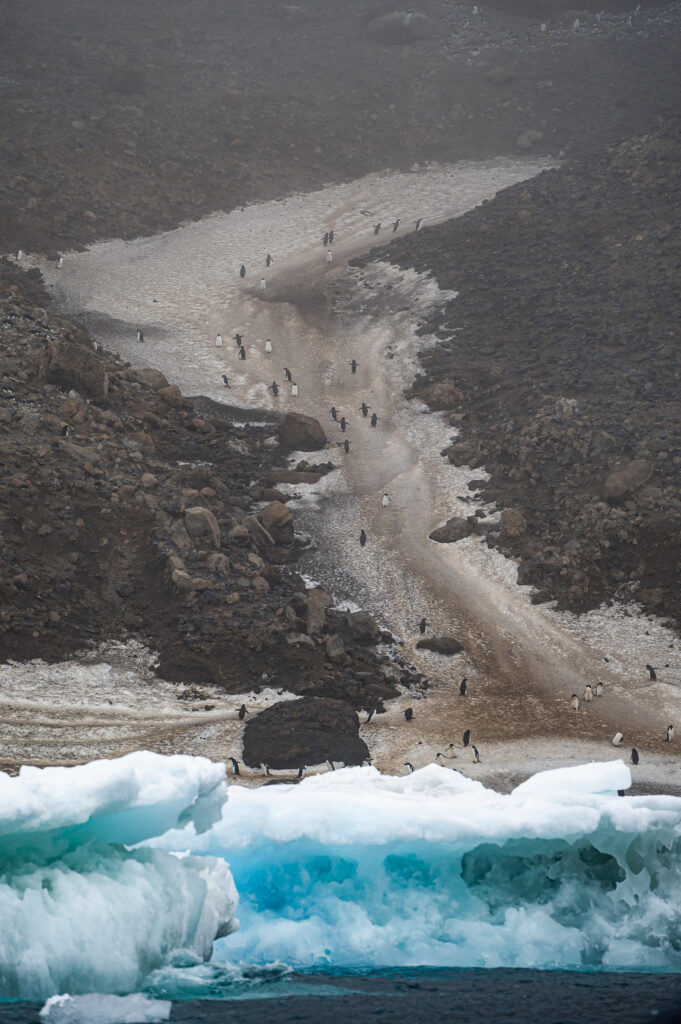
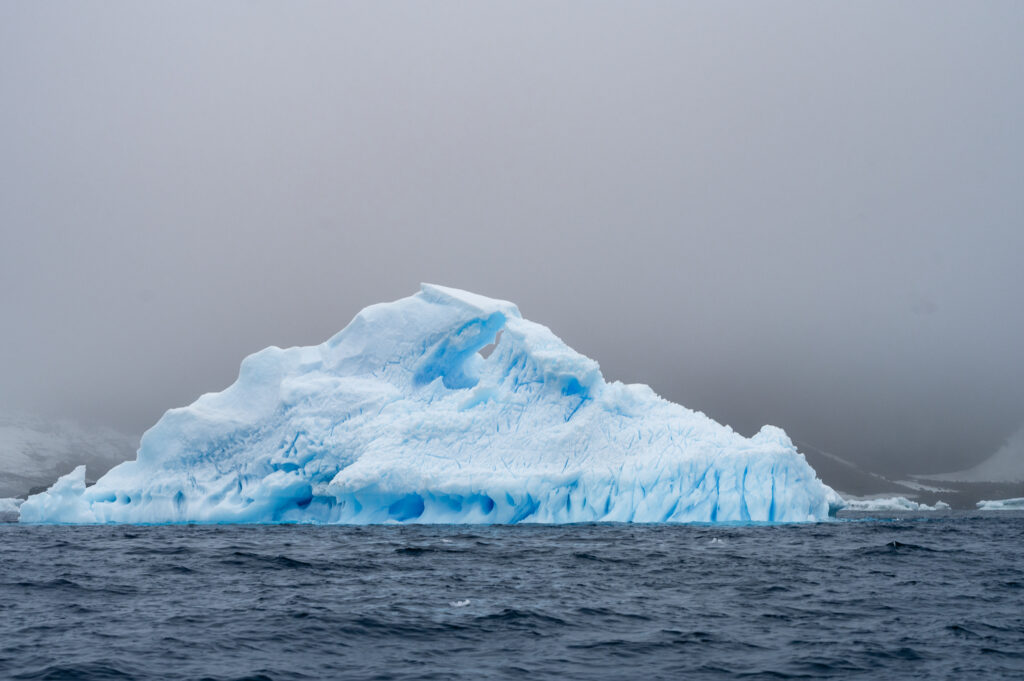
In the afternoon, we had another Zodiac cruise, but this time we were more prepared and knew how to dress warmly. This cruise was around Hope Bay, where there was a functioning research centre originally set up by Argentina. It was a proper community with many homes, a school, and research facilities. It was also the one place where a child had been born in Antarctica. It was fascinating to see such a wilderness area properly inhabited by humans, but also, more Adelie penguins. The most exciting part of this Zodiac cruise was that I spotted a humpback whale just a few metres away and saw its tail flip.
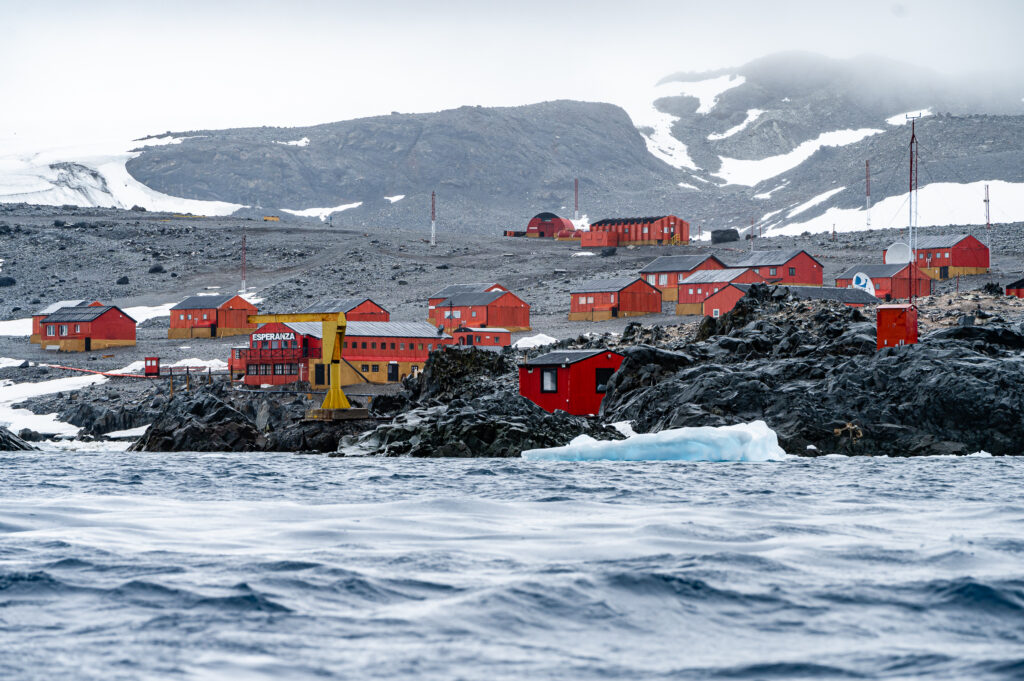
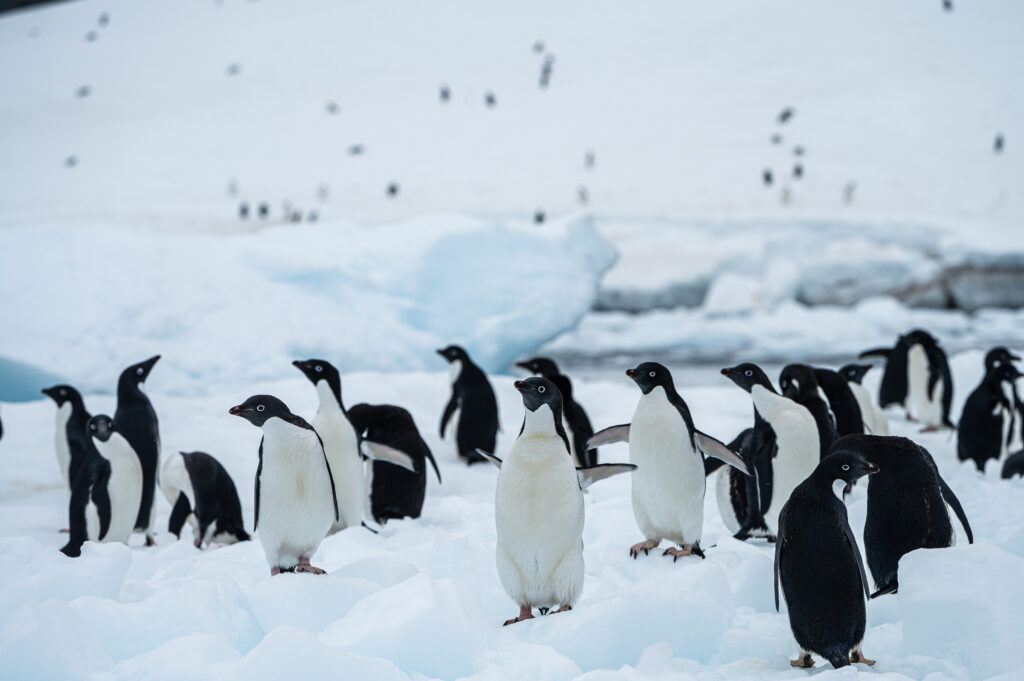
Day 5
This morning we were able to have another proper landing on a place called Palaver Point on Two Hummock Island. It was a much more difficult hike than we expected, the fresh snow was sinking below us, and we were sliding up and down with the high incline. It was completely worth it to see a massive colony of the cutest Chinstrap penguins, climbing up and down alongside us. As we got closer to the viewpoint peak, there was moss growing on the rocks, a phenomenon that takes thousands of years to grow, and completely unexpected when all you’ve seen is ice and dark brown ground.
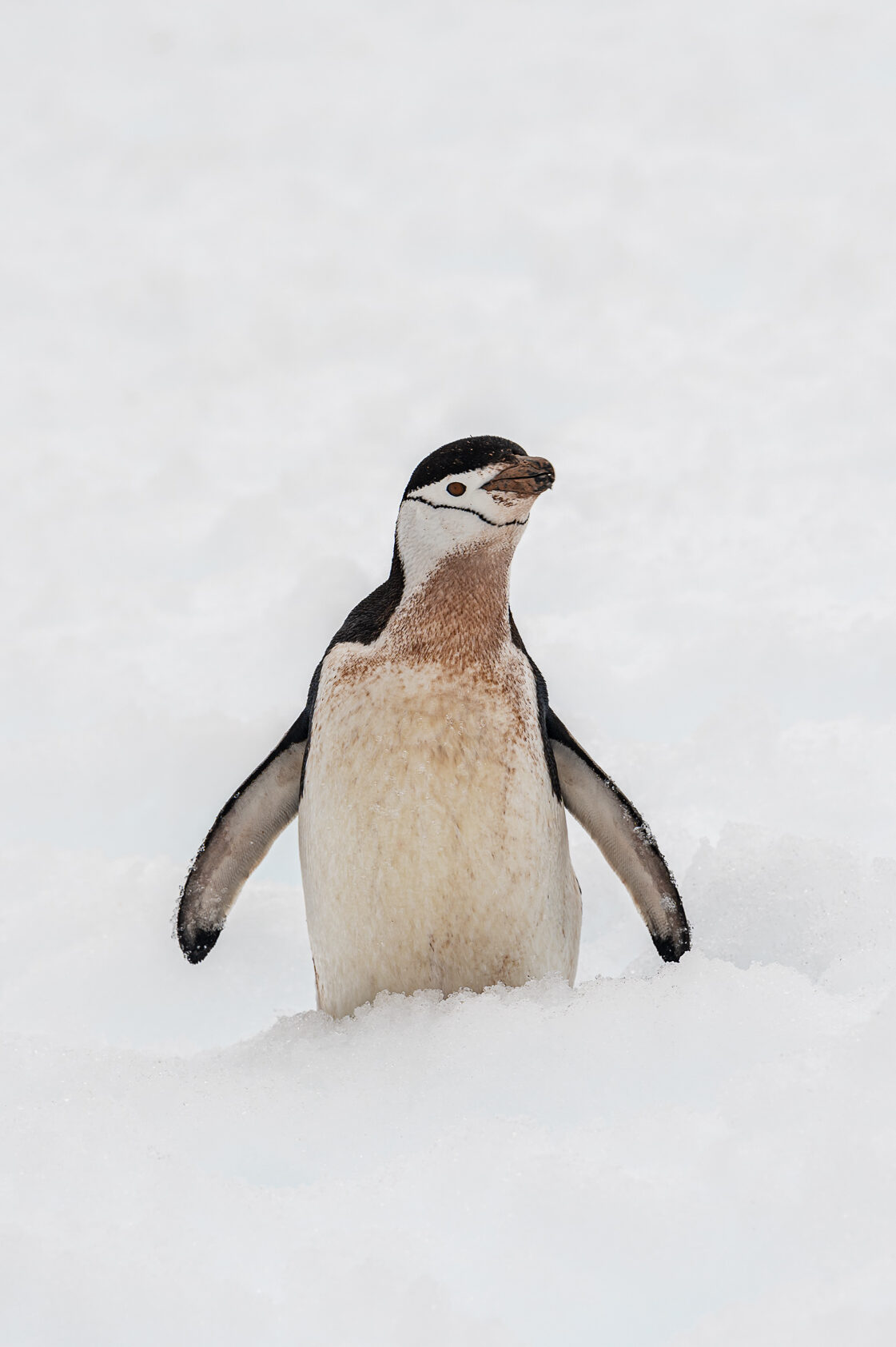
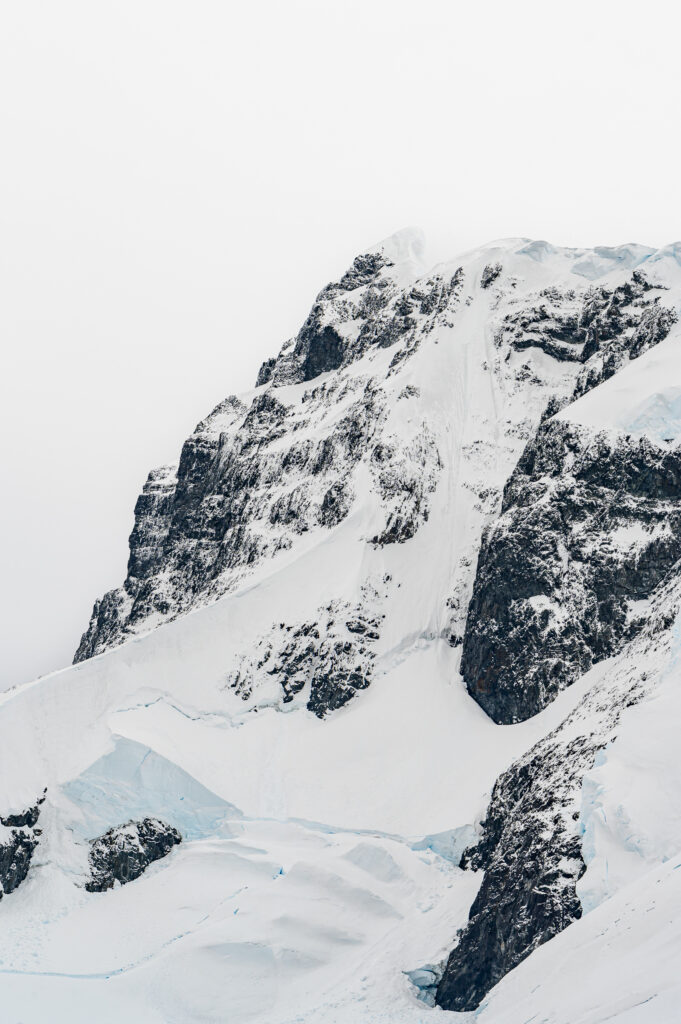
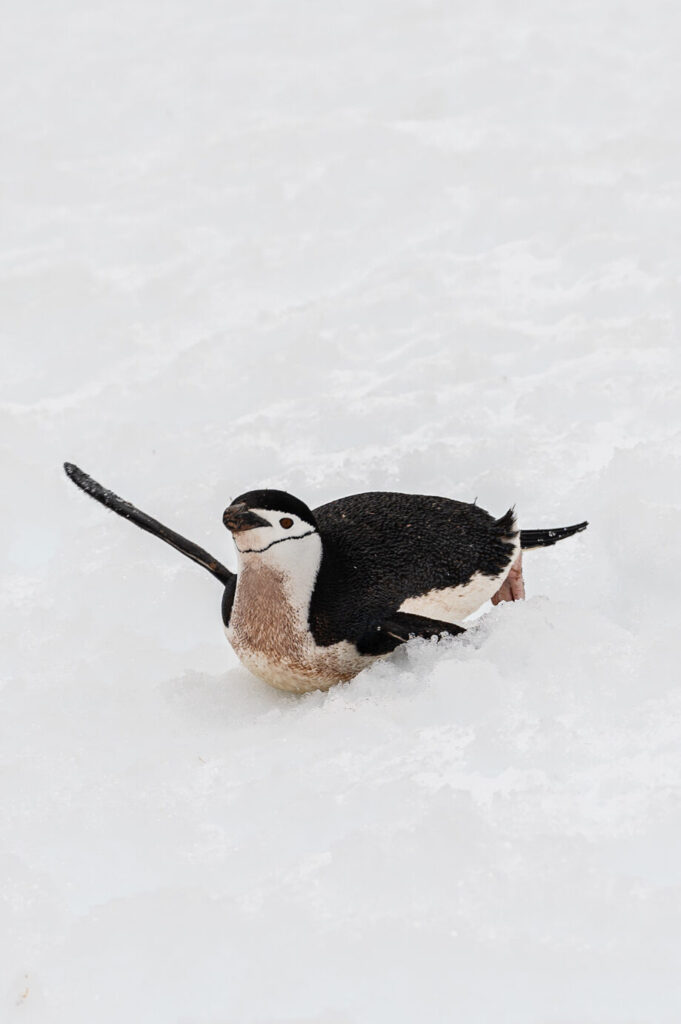
Our second location was Kayak Bay where we took a Zodiac cruise to see icebergs and another colony of Chinstrap Penguins. The bay had so much ice floating around that we had to navigate very slowly around the larger pieces, but this allowed us to touch the floating ice, and my husband decided to even taste it as well. The verdict was that it was salty on the outside, but normal ice on the inside (Surprise!). Some of the larger pieces of ice floating had clearly melted off of larger pieces that included some rocks and other pieces of dirt, deeply embedded and had been there for years.
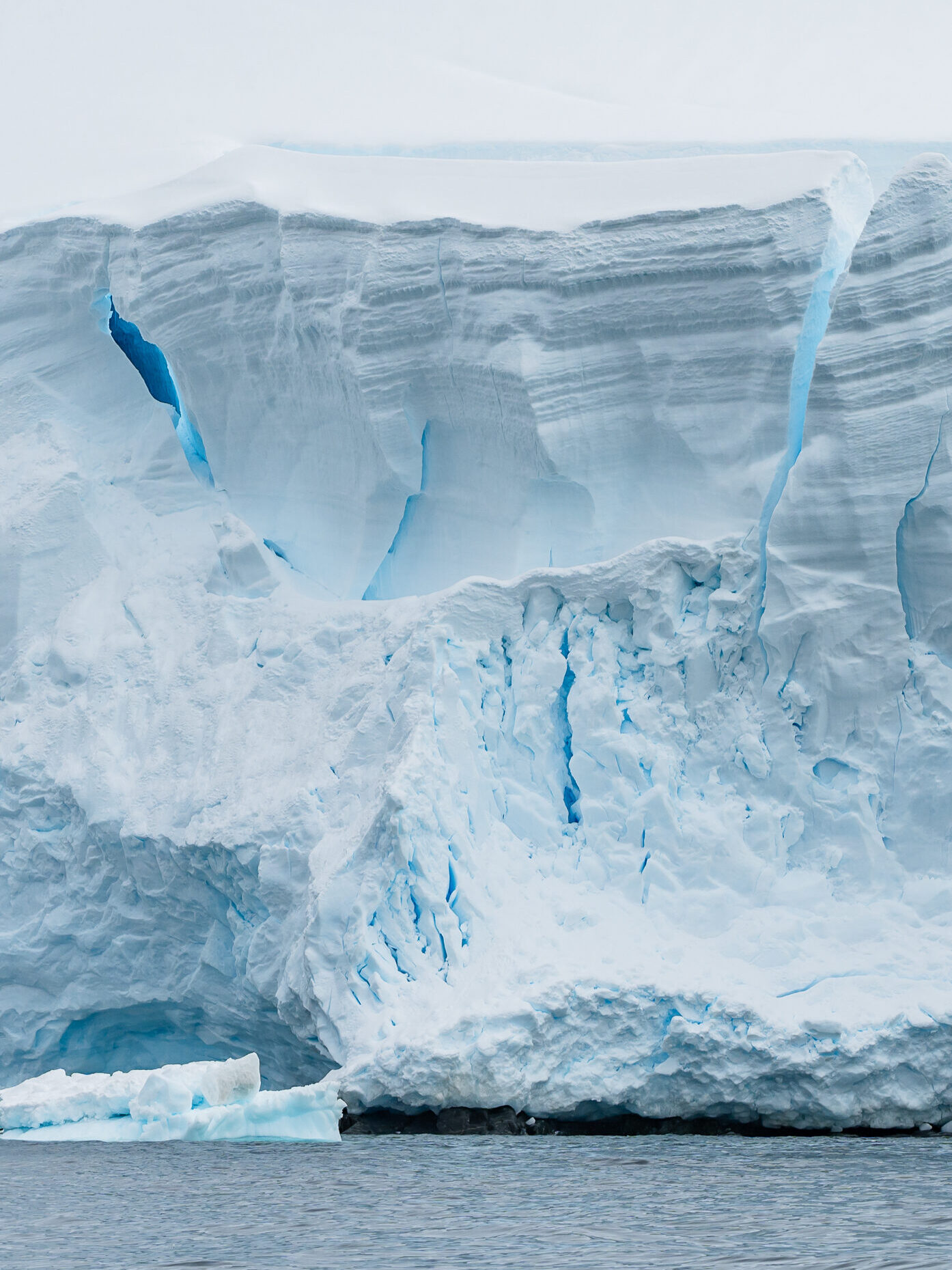
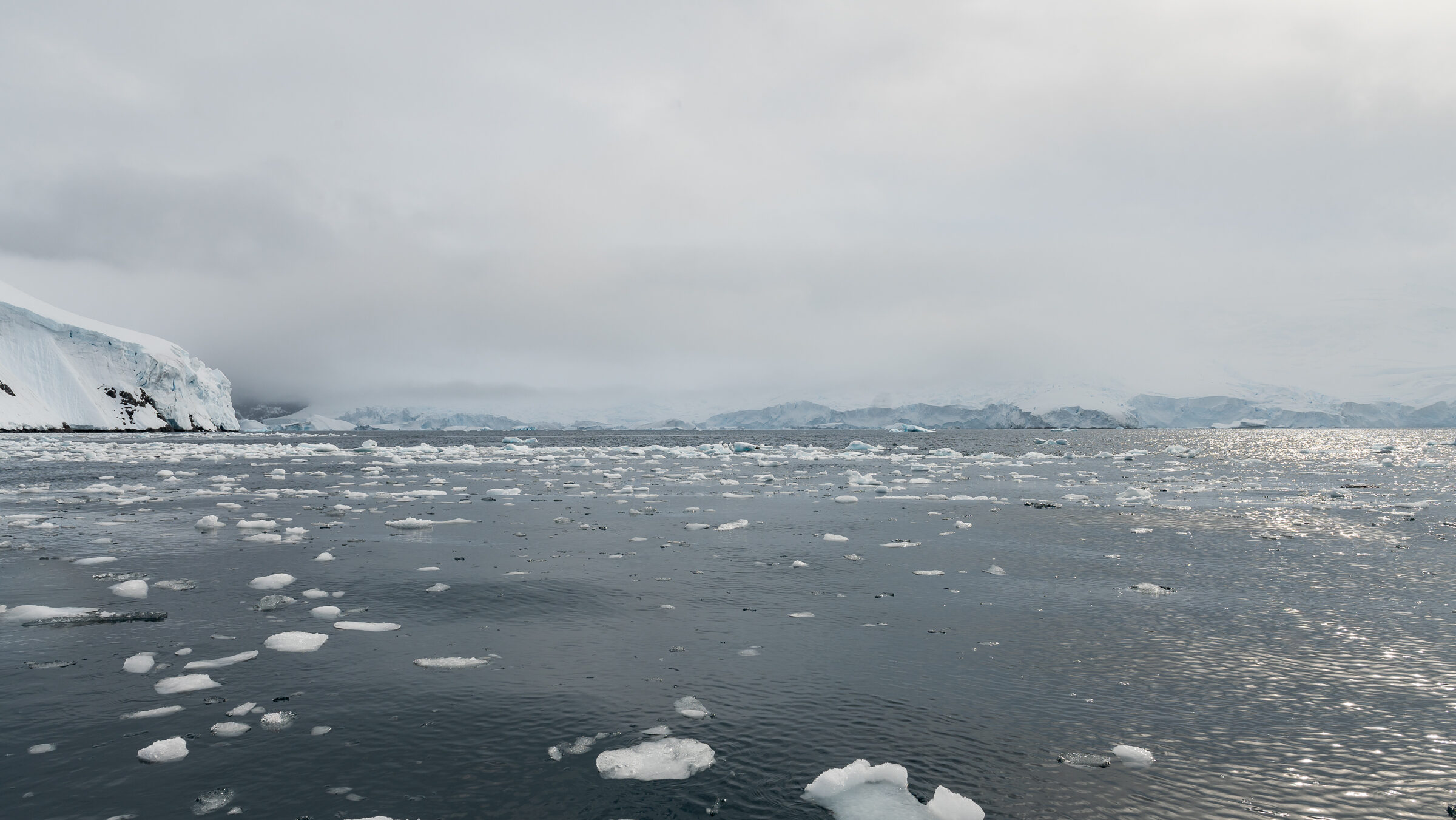
Day 6
My initial expectation of the expedition was that we would perhaps get on land a couple times and sail through some icebergs. This was already surpassing those expectations. Each day they had planned amazing landings or zodiac cruises and today was nothing less. Our first location today was Cierva Cove which was known for many krill and consequently many whales. After Day 4’s experience, I was ready in all my waterproof gear and zoom lens for the whales to show me some tail.
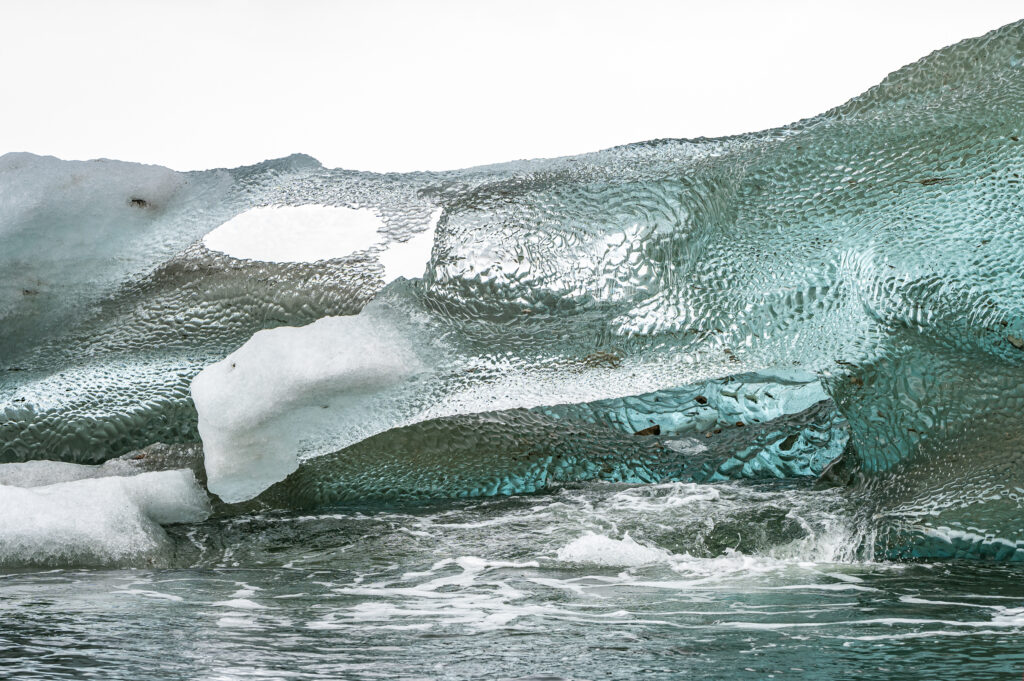
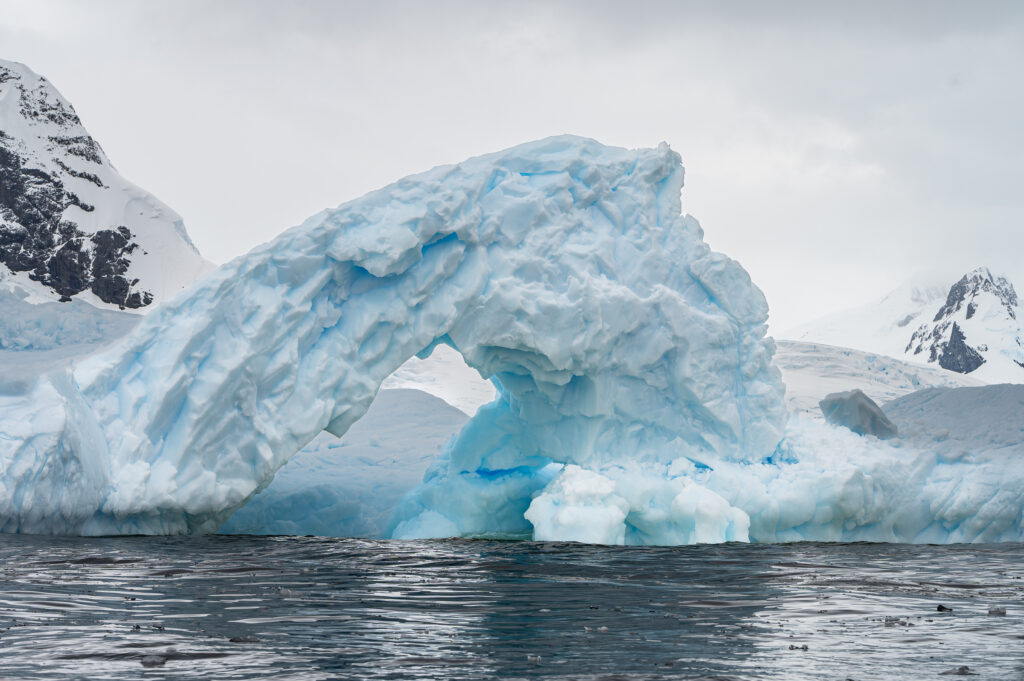
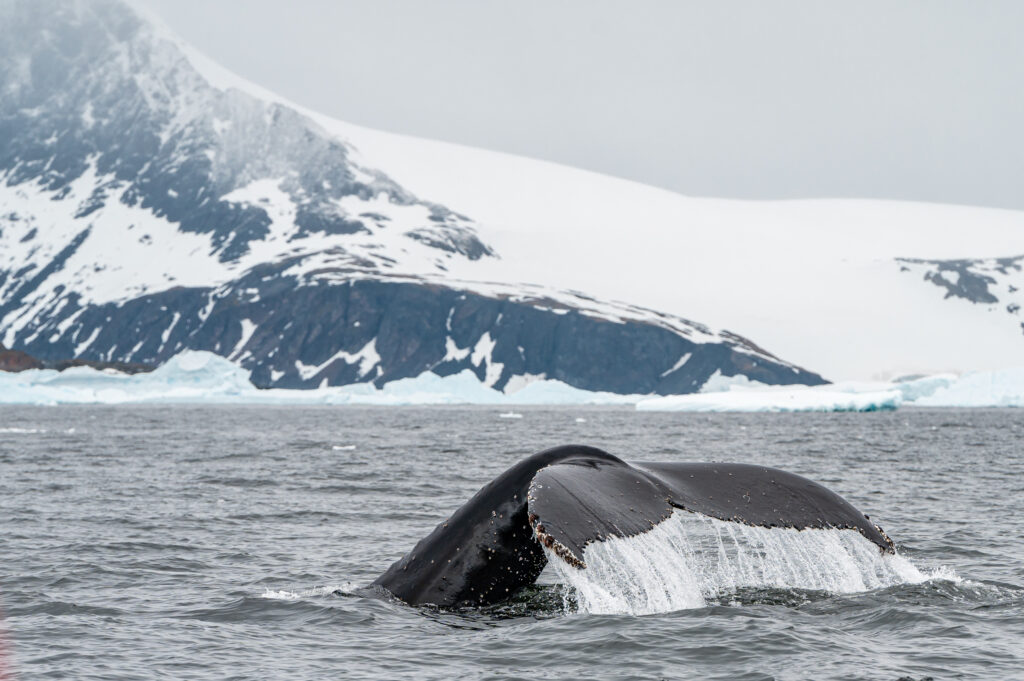
Our group was the last to leave the ship at around 9am, the wind chill was high so we wore all our gear. As we cruised around we saw some amazing natural ice sculptures and icebergs, but unfortunately no whales. One of the ice sculptures had green and blue colours inside with golf-ball like indents and had created its own mini lagoon. There were multiple crazy phenomena like this and seeing them close-up was magical. Just when we were about to head back to the ship, we saw a couple of humpbacks and I got extremely trigger happy with my camera. Luckily the whales are all very predictable with when they will tail flip and always gave us enough time to take photographs or videos.
In the afternoon we had a landing on Mikkelson Harbour where there was a massive whale skeleton on the shore with a Weddell seal sleeping in the middle of the bones. The island had a large population of Gentoo penguins which are mainly distinguishable by their orange beak. They had taken over an abandoned hut and weather station set up by Argentine explorers, along with setting up multiple penguin highways of their own to waddle around the island. It was snowing heavily, and watching them figure out whether they want to walk, or jump, or even slide in the snow was extremely amusing and so cute, but man, they were a stinky bunch.
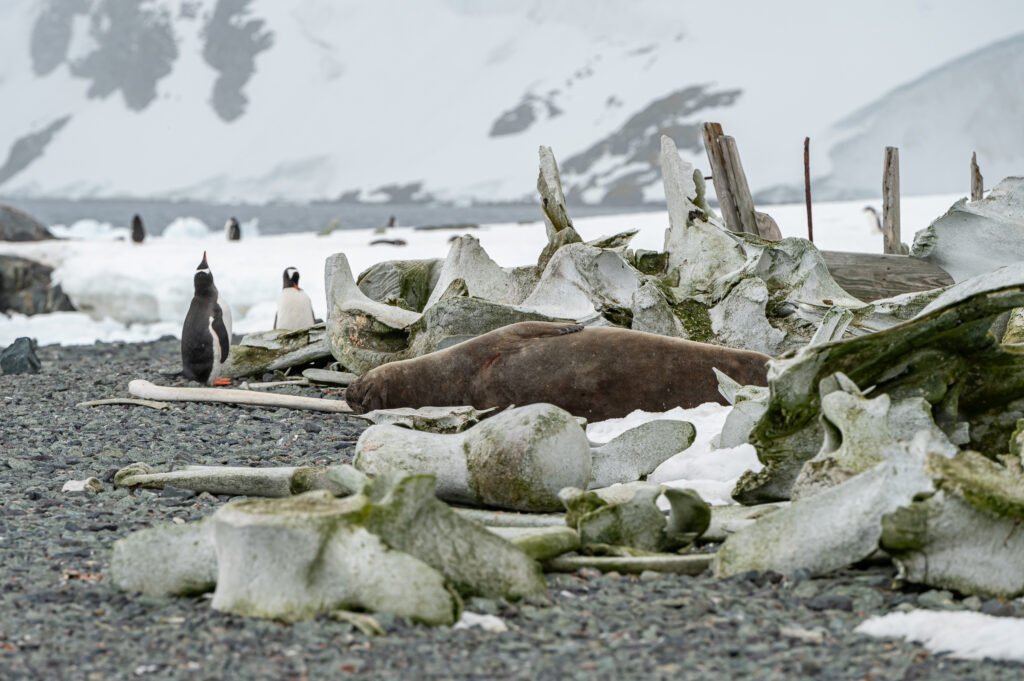
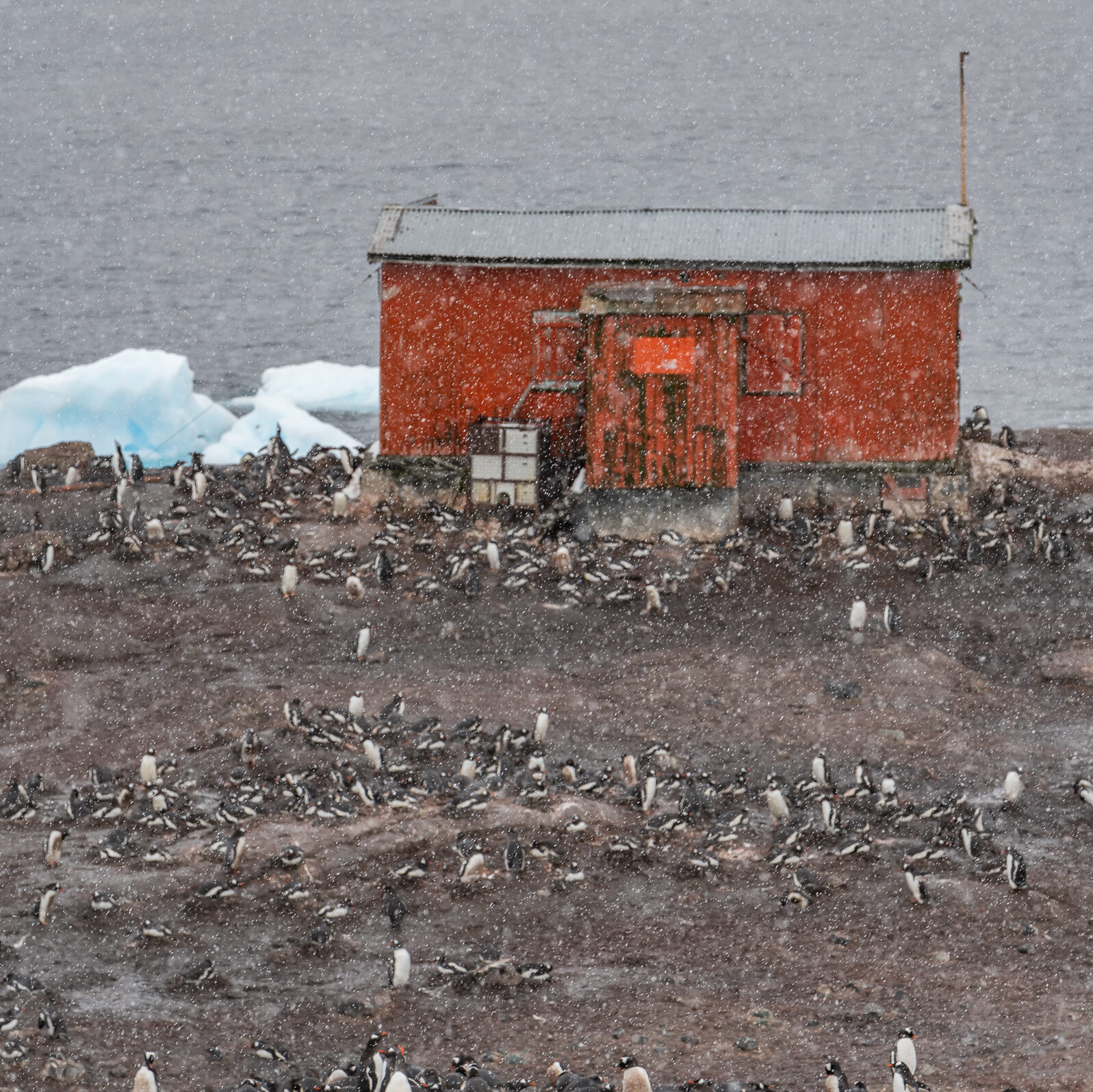
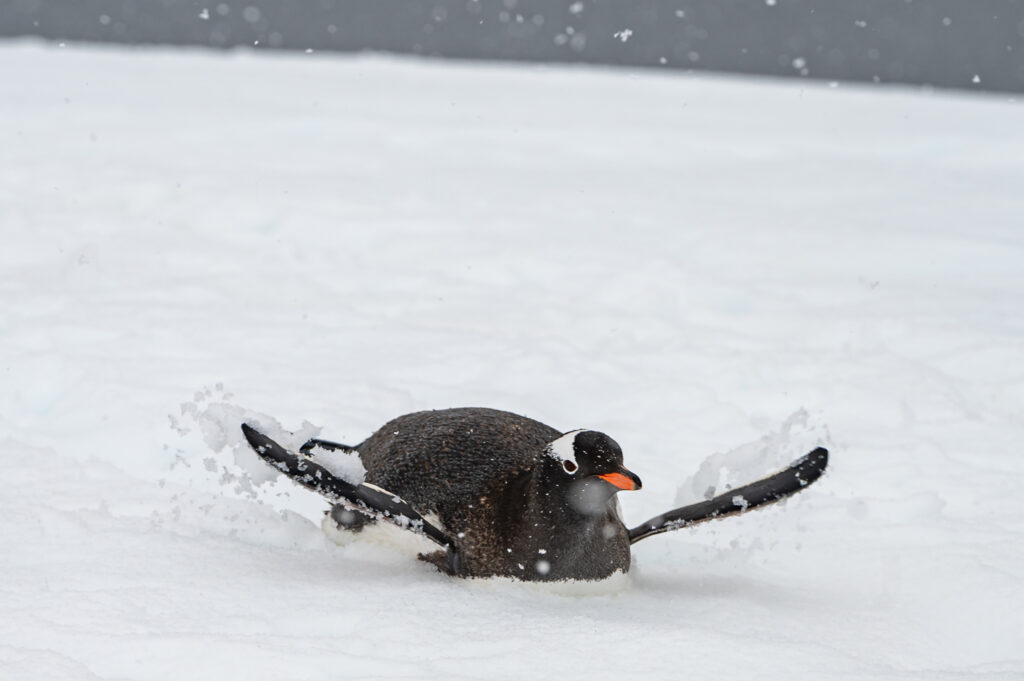
Day 7
This was the best day so far, not just because of where we were, but for the first time the sun was out and we could see the snow and ice glistening all around us. We were docked at the most beautiful inlet of the Antarctic Peninsula called Neko Harbour, surrounded with massive deep blue glaciers and is home to over 250 breeding pairs of Gentoo penguins and some Weddell seals. This was a pretty difficult hike up to the viewpoint on the harbour but it was definitely worth it to see the fog part and the sun beat down, to the point where you could see the glacier formations under the clearest water.
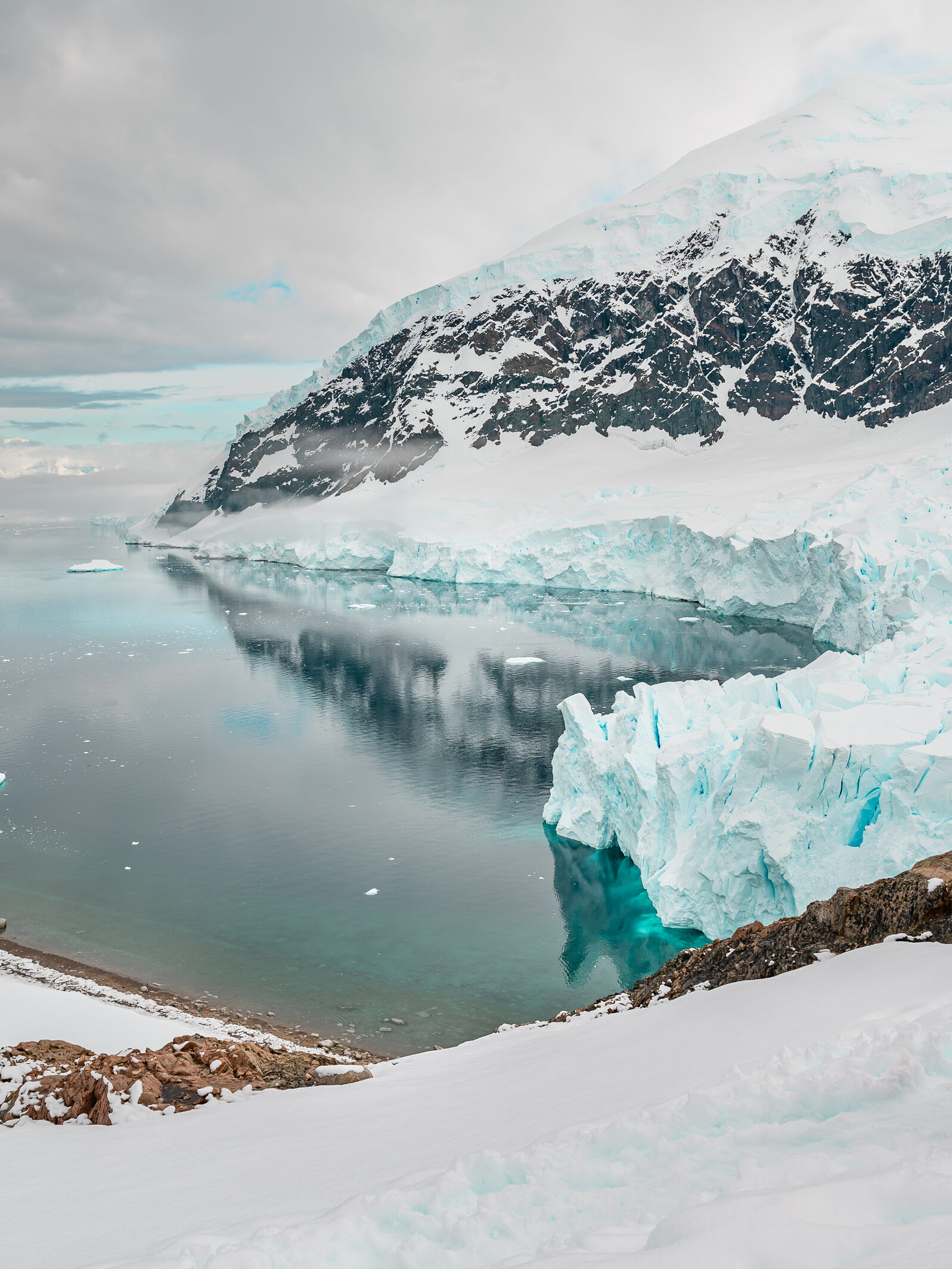
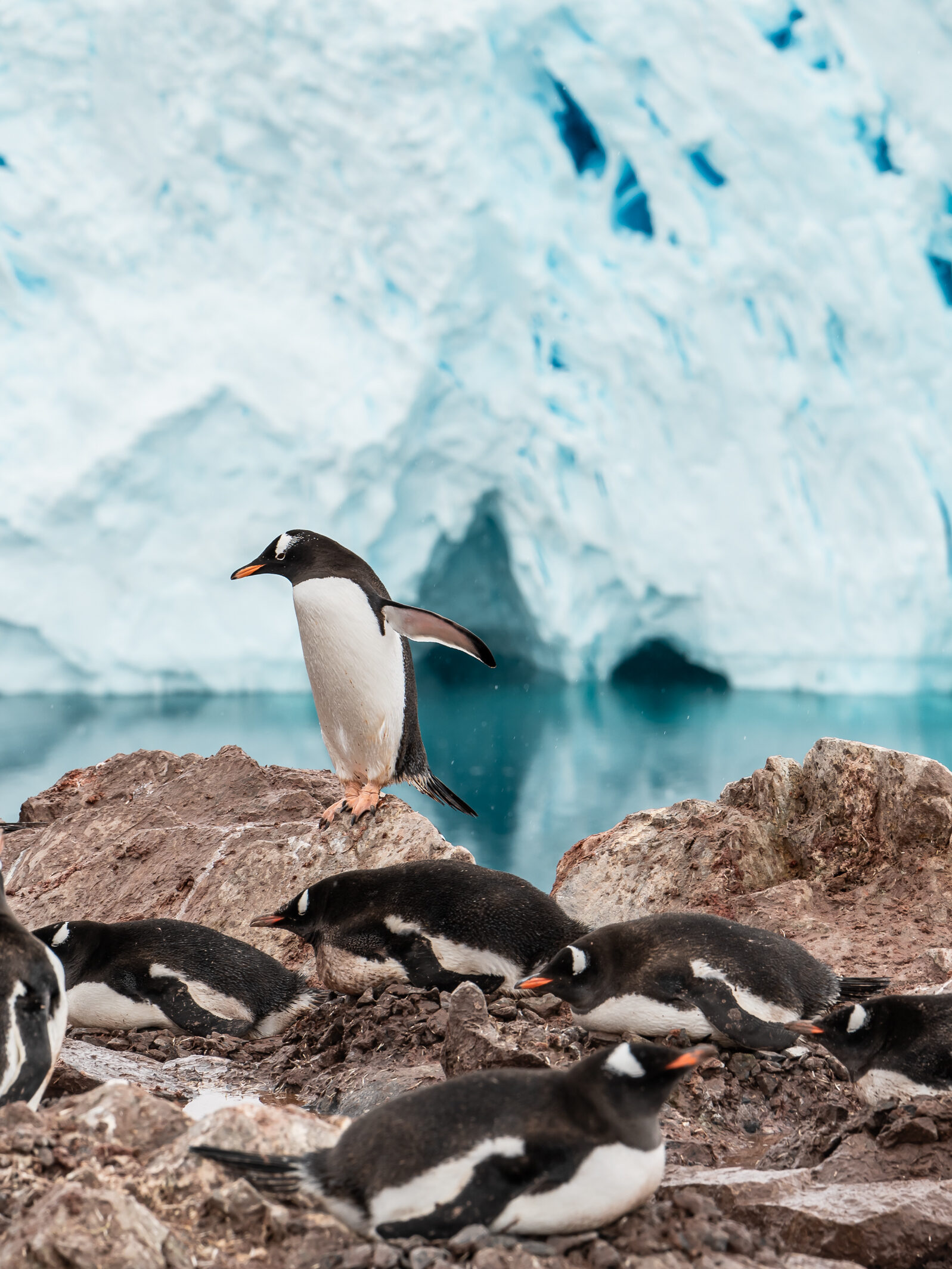

Our second landing was another beautiful landing and hike on Danco Island. Two hikes on Antarctica in one day was a lot, but it was worth all the trudging through the snow. By this point, the sun had reached its peak and the temperature had risen up to 8ºC; it was warm enough that we didn’t even need more than a light jacket (still had to be waterproof though!). The guides always made sure to create a path that zig-zagged and wasn’t at too high of an incline or ever interrupting the penguin highways. For the first time, there weren’t any penguins around us, but there was a massive family of whales swimming around, so when it was time to return to the ship, the expedition staff took us for a spin around the bay on the zodiac, for a short whale spotting cruise.
Today the guests were also allowed to do the ‘Polar Plunge’ if they chose to. I had already done one in Norway, so I decided to just take photos of my husband doing it, along with 90 of the other guests, including some that were above 80! Before you jump in, they let you take a shot of the liquor of your choice, then put you in a harness and you jump off a mini pier attached to the ship. They let you stay in for a few seconds before reeling you back. I was watching from one of the upper decks, and each person as they came out, had a complete look of shock on their face, certainly great entertainment for the evening.
Day 8
This was our last day in Antarctica, but by this point we were pros at preparing for any type of expedition. The weather was still pleasant hanging out at a balmy 4ºC so I continued to wear my lighter puffer jacket. Our first landing at Portal point was easy going with hikes up two small hills, this time with more Gentoo Penguins. Since it was our last day, the guides took us on a short cruise after our hike as well, to give us a jam-packed last day to see the crazy icebergs in that bay.
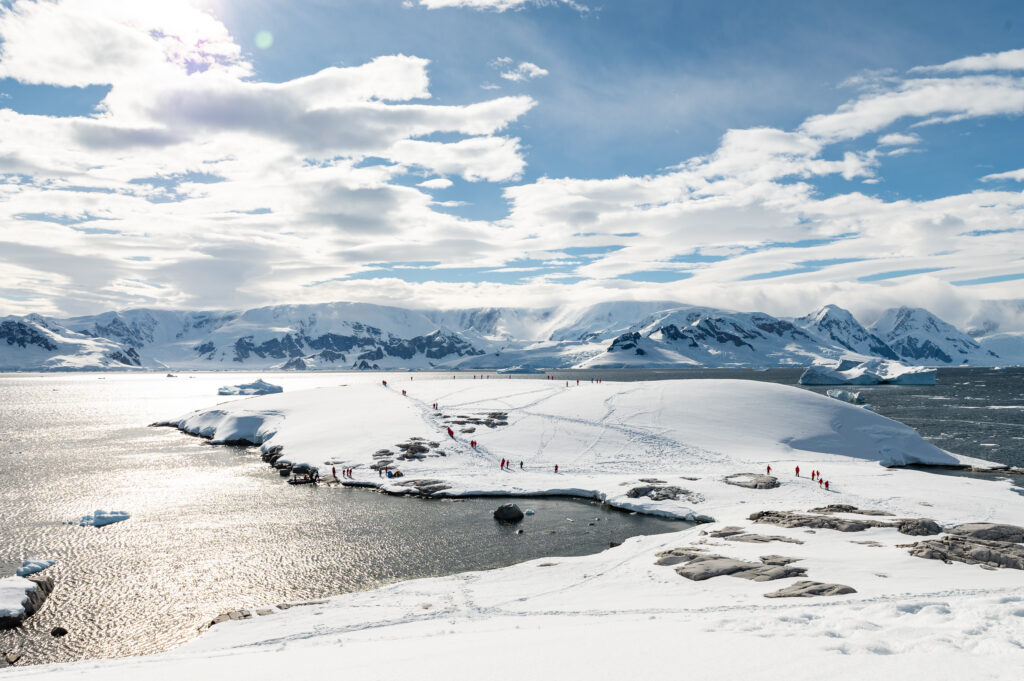
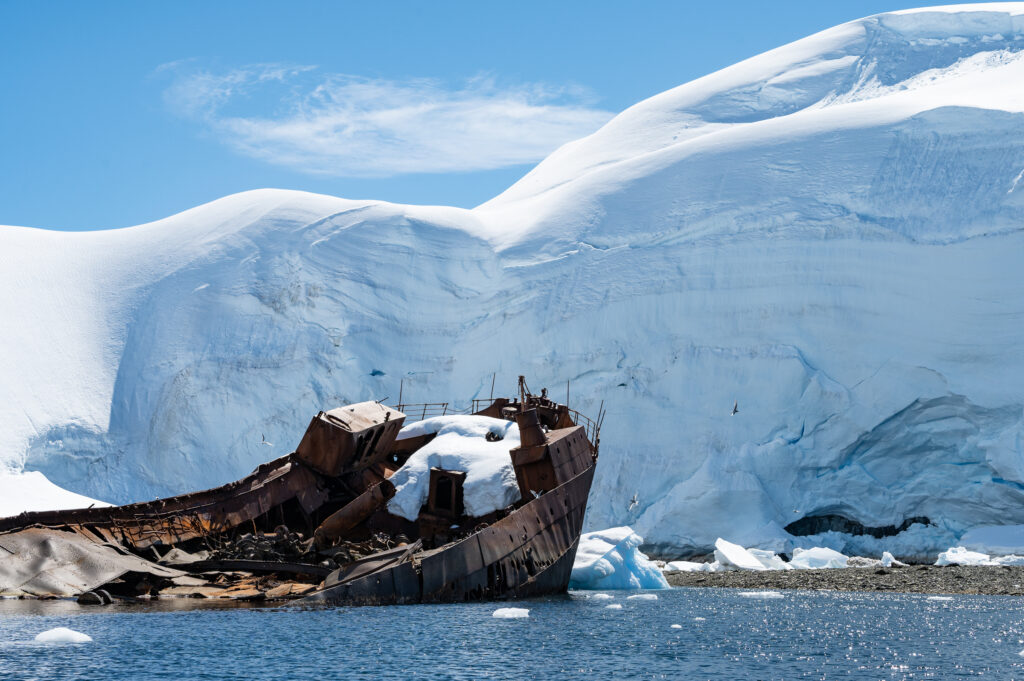
In the afternoon I noticed that there were less people going out for the expedition. I think 5 straight days of major physical activity in freezing temperatures was starting to take a toll, and a few guests started to get ill. We still went out on our final expedition, a Zodiac cruise to see Enterprise Island and a whaling vessel ‘Gouvernoren’ wrecked on its shores. Only its bow is above water, the rest of the vessel is only visible if you look under the water on calm days. The crew had also set up a surprise booze boat on the water, where they had prepared glasses of champagne and hot chocolate to celebrate the culmination of our amazing expedition to Antarctica.
Day 9 & 10
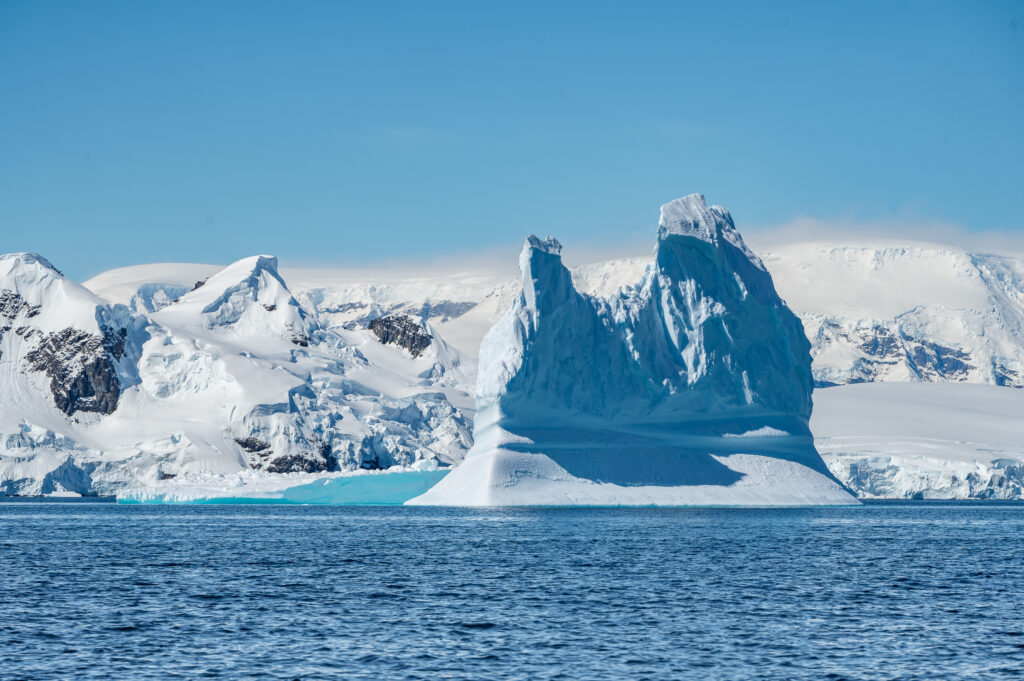
Our first day’s journey back to Puerto Williams was one of the roughest days at sea I had ever experienced in my 3 years of being on ships. The Drake passage was not very forgiving on our small expedition ship and the wave swells were up 6m high (almost 20 ft!). The captain was trying to avoid an even bigger storm and therefore steamed ahead at double the speed. Guests were barely around the decks, probably lying down in their beds dealing with seasickness. We mostly only went out for our meals and to get some fresh air when the winds weren’t too crazy but we chose to make it a quiet day and order in-room dining, utilising all the perks of being in a 5-star service ship. By that night itself, we were within a few nautical miles from the tip of South America and reached Puerto Williams a day early.
The final day at sea was actually a day at anchor. We weren’t able to dock at the pier until later that night, so the ship was floating close enough to Puerto Williams that we were getting a network signal. The ship’s crew had organised multiple activities and talks for us to attend on the final day to stay occupied, including trivia, games, a photo contest, and a captain’s farewell. It was really nice to spend time with the guests and crew with whom we had shared such a crazy adventure. By 11pm we had packed our check-in luggage and placed it outside, which would meet us again in Santiago airport.
Day 11
At 8am we had to vacate our cabins, and we were out of the ship by 1015am. They took us to Santiago the same way we left, a small charter plane to Punta Arenas, then a larger one to Santiago Airport. We arrived in Santiago, Chile around 6pm, collected our luggage and were taken to The W Santiago by 8pm. From that point, we were on our own as we had chosen to organise our own travel. We had decided to stay in South America for a few extra days to explore Cuzco and Machu Picchu, an adventure I will save for another time.
Final thoughts
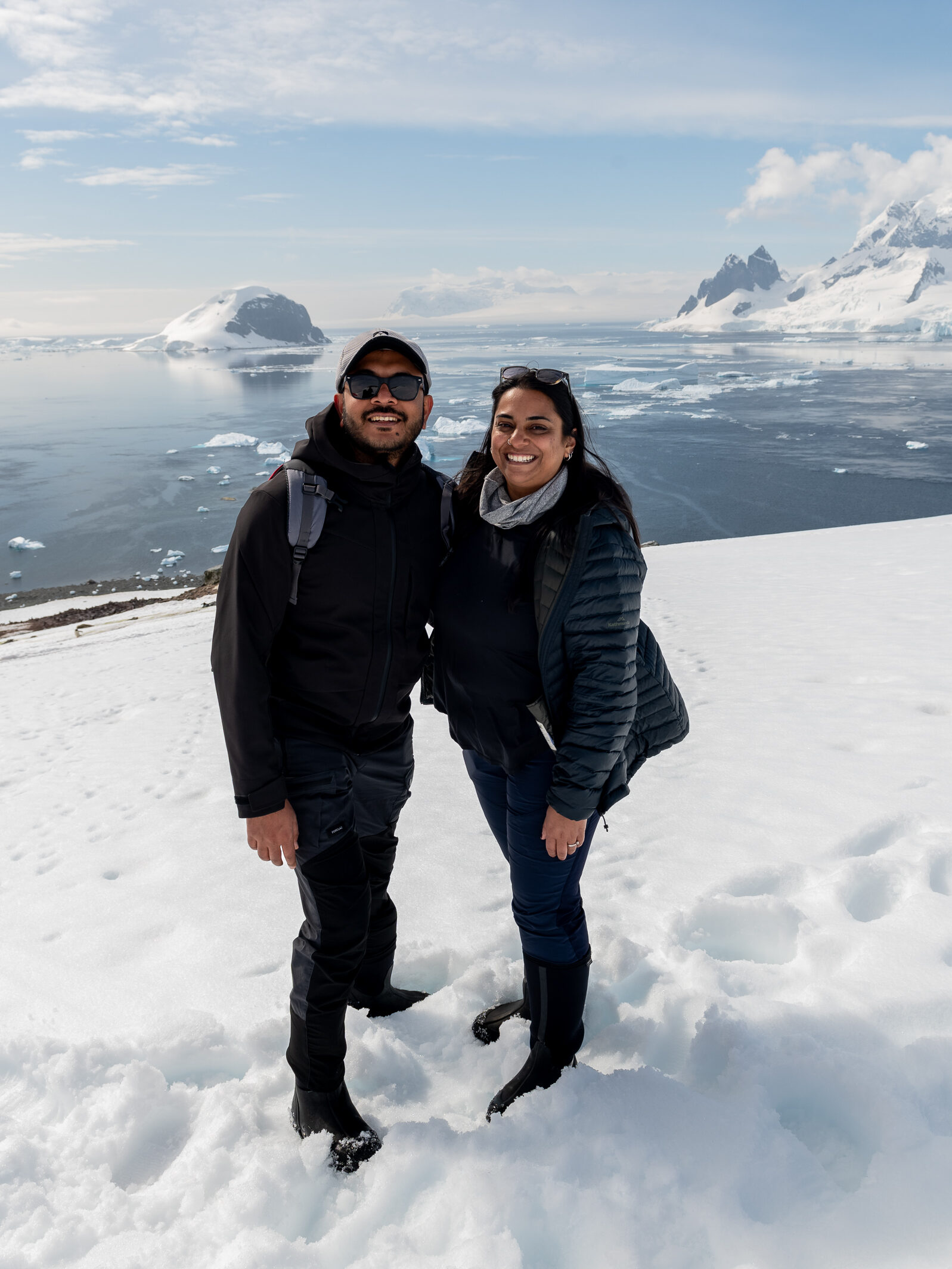
From initial planning to the end of the trip, I think it was definitely worth every little bit that we paid for it; it surpassed our expectations in almost every way. We thought that we would only have the opportunity to land or get on a Zodiac a couple times . Turns out we had 10 excursions and 1 bonus landing that was never part of the itinerary. Each landing had something different to offer, and an abundance of penguins that I will never tire of seeing. The landscapes were remarkable, and such a rich education and experience in such a short span of time.
I wanted to share a few thoughts that will stay with me, and a few that I wish someone had told me before I went. I think what’s most important is that Antarctica is for everyone! Whether you are 18 and ready for adventure, or 80 and want to go to your 7th Continent. The expedition staff make sure that there is something for everyone of all physical abilities. All you really need to be able to do is climb a few steps, and get your legs over the side of a raft. Unfortunately, there wasn’t much there for kids, and a lot of activities such as the polar plunge or kayaking weren’t available to anyone under the age of 16.
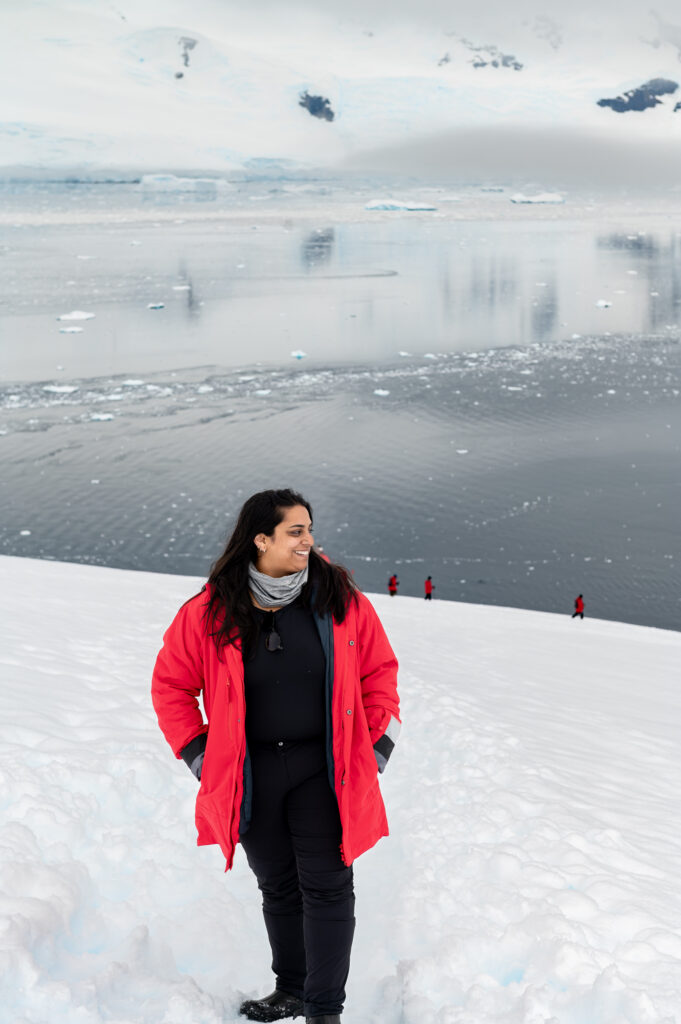
Second thing that I wish I had known was to pack light! Most of the time you will be wearing a heavy jacket and waterproof pants, so just a few flannels and thermals underneath, and a couple days worth of regular clothes for around the ship is more than enough. They had free laundry machines available to us everyday, so if you run out, you can always wash.
I can not stress how important waterproof pants and clothes are as well. My pants were not as waterproof as I thought, and often I would return back to the ship with a wet and frozen behind. The parka is waterproof, but if you’re bringing your own boots and pants, double check for insulation and waterproof (not just water resistant). They also say seasickness meds are optional, but I would bring them anyway. You may have the strongest stomach, but the Drake passage doesn’t discriminate and will affect everyone.
Finally, this is a once in a lifetime opportunity, and that means that you’ll want to document every part of it with photos and videos. Make sure you have a great phone camera with enough storage, or if you’re a photographer like me, a few hard drives and SD cards to make space for all your footage from your camera. Everything will feel like a moment to capture, but Antarctica is massive and gorgeous all around, so put the phone/camera down on occasion, and just take in the magnificence around you. Trust me, you’ll see the penguins, whales, seals, and icebergs again if you miss it the first time.
More Photographs available here: https://nishtakumar.com/antarctica/
